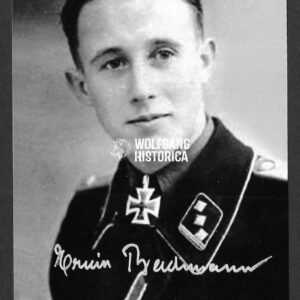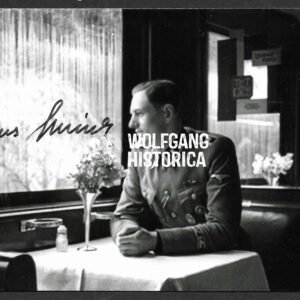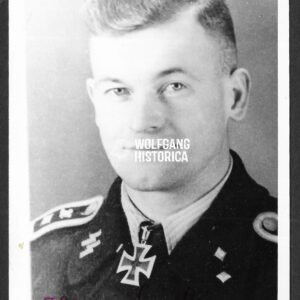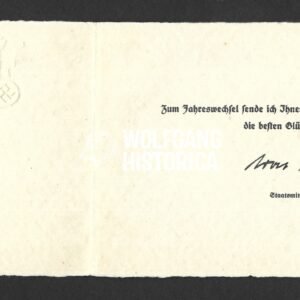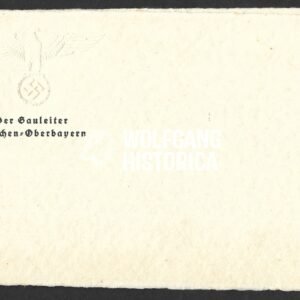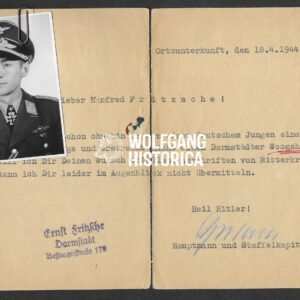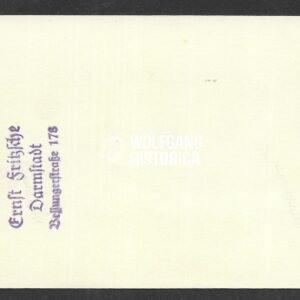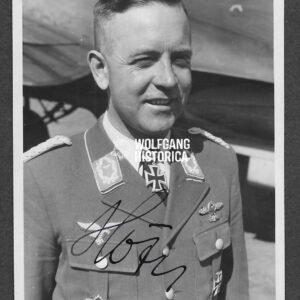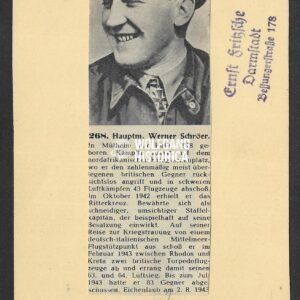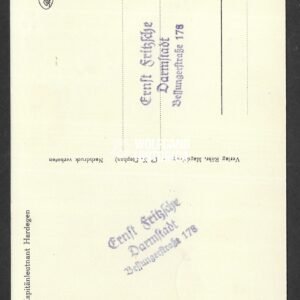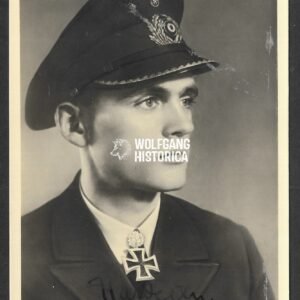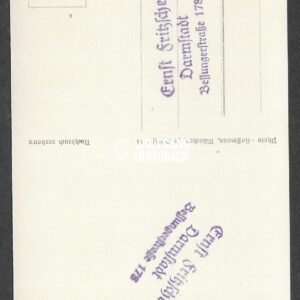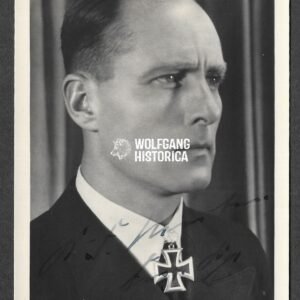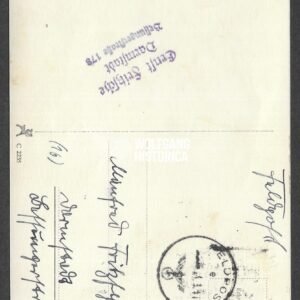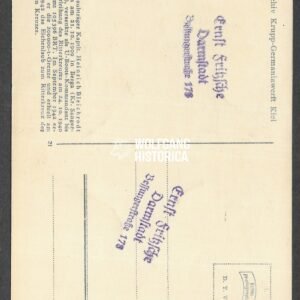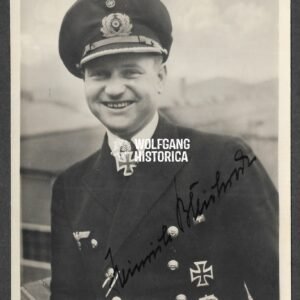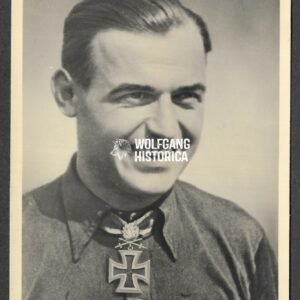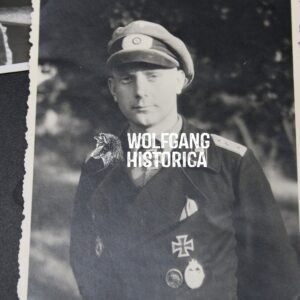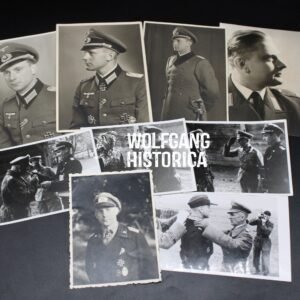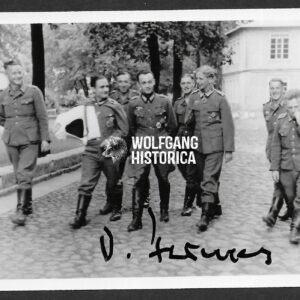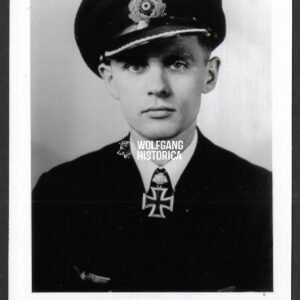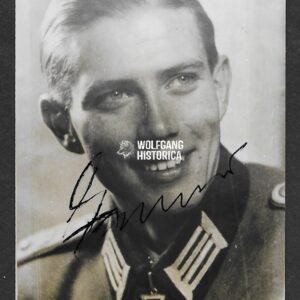Customers facing issues ordering, contact me
via info@wolfganghistorica.com or wolfganghistorica@gmail.com
NEW HOUTEN MILITARIA FAIR VIDEO ONLINE: Watch it here!
Leon Degrelle – 28. SS-Freiwilligen-Panzer-Grenadier-Division “Wallonië”
€250,00SS-Standartenführer Leon Degrelle (15 June 1906, Bouillon † 31 March 1994, Málaga) was the Belgian leader of the Rexist Movement and one of the most famous foreign volunteers to serve in the Waffen-SS during the Second World War. He rose from enlisted service to command the Walloon volunteers on the Eastern Front, eventually leading the 28. SS-Freiwilligen-Grenadier-Division “Wallonien.”
Degrelle distinguished himself in heavy fighting against Soviet forces, receiving some of the highest decorations awarded to non-German volunteers. He survived the war, escaping to Spain where he lived in exile until his death in 1994.
Awards and Decorations
-
Knight’s Cross of the Iron Cross (Ritterkreuz des Eisernen Kreuzes) – 20 February 1944, as SS-Hauptsturmführer and Führer of 5. SS-Freiwilligen-Sturmbrigade “Wallonien.”
-
Oak Leaves to the Knight’s Cross (Eichenlaub) – 27 August 1944, as SS-Sturmbannführer and Kommandeur of 28. SS-Freiwilligen-Grenadier-Division “Wallonien.”
-
Close Combat Clasp in Gold (Nahkampfspange in Gold) – 14 September 1944.
-
Additional decorations included the Iron Cross 1st and 2nd Class and Infantry Assault Badge.
Item Details
-
Authentic scarce postwar signature of Leon Degrelle.
-
Signed on a large format postwar photo
-
Condition: As seen – scarce and collectible.
- Color lines in the scan are from scanning, not in the original.
Collector’s Note
Leon Degrelle remains one of the most controversial and well-known foreign volunteers of the Waffen-SS. His rise from volunteer soldier to divisional commander, along with his postwar exile and continued notoriety, makes his autograph especially rare and sought-after. This large-format signed photo is an exceptional piece for advanced collectors of Waffen-SS history, foreign volunteer units, and Knight’s Cross recipients.
4× Signed Knight’s Cross Holders !! of the 8. SS-Kavallerie-Division “Florian Geyer”
€200,00Original postwar photograph, signed four times by decorated officers of the 8. SS-Kavallerie-Division “Florian Geyer.” The postcard-sized photo depicts several Knight’s Cross recipients from the division and bears the autographs of the following highly decorated officers:
-
SS-Sturmbannführer Johannes Göhler (15 September 1918 – 21 February 2003)
– Awarded the Ritterkreuz des Eisernen Kreuzes on 17 September 1943 as SS-Obersturmführer and Kommandeur 4./SS-Reiter-Regiment 1 of the 8. SS-Kavallerie-Division “Florian Geyer.” -
SS-Obersturmführer Siegfried Korth (5 February 1922 – 6 October 1996)
– Awarded the Ritterkreuz des Eisernen Kreuzes on 9 February 1945 as SS-Obersturmführer and Chef 3./SS-Kavallerie-Regiment 18 of the 8. SS-Kavallerie-Division “Florian Geyer.” -
SS-Sturmbannführer Gustav Lombard (10 April 1895 – 18 September 1992)
– Awarded the Ritterkreuz des Eisernen Kreuzes on 25 January 1943 as SS-Sturmbannführer and Kommandeur SS-Kavallerie-Regiment 1 of the 8. SS-Kavallerie-Division “Florian Geyer.”
Lombard was one of the most experienced cavalry commanders of the Waffen-SS, serving from the early campaigns in Poland and the Soviet Union through to the end of the war. -
SS-Hauptsturmführer Anton Vandiecken (28 March 1918 – 18 June 2000)
– Awarded the Ritterkreuz des Eisernen Kreuzes on 16 April 1945 as SS-Hauptsturmführer and Kommandeur SS-Kavallerie-Regiment 18 of the 8. SS-Kavallerie-Division “Florian Geyer.”
Vandiecken distinguished himself during the final defensive battles in Hungary and Austria in 1945.
Details:
-
Four original postwar signatures in ink on the front of the photograph.
-
Condition: Very good; strong contrast, clean autographs, light edge wear.
-
Dimensions: Postcard size (approx. 9 × 14 cm).
Collector’s Note:
A rare and historically significant multi-signed photograph featuring four Knight’s Cross holders of the 8. SS-Kavallerie-Division “Florian Geyer.” Group-signed examples of this caliber — especially including Lombard, Göhler, Korth, and Vandiecken — are exceptionally scarce and highly desirable among collectors of Waffen-SS cavalry, Knight’s Cross recipients, and SS divisional history.
Heinz Golinski – 8. SS-Kavallerie-Division “Florian Geyer”
€35,00Erwin Bachmann – SS-Panzer-Regiment 10 “Frundsberg”
€55,00Original postwar signature of Erwin Bachmann on a postwar photograph. Bachmann (5 May 1921 – 18 February 2010) served as SS-Obersturmführer and Adjutant in the I. Abteilung / SS-Panzer-Regiment 10, part of the 10. SS-Panzer-Division “Frundsberg.”
He was awarded the Ritterkreuz des Eisernen Kreuzes (Knight’s Cross of the Iron Cross) on 10 February 1945 for outstanding leadership and bravery in the closing months of the war. The reverse of the photo bears a personal dedication to a fellow Waffen-SS veteran, adding a unique element of provenance and historical interest.
Details:
-
Authentic postwar autograph signed “Erwin Bachmann.”
-
Condition: Very good; minor handling wear; clear signature and dedication on reverse.
-
Format: Postcardsize
Collector’s Note:
A scarce and desirable signed photograph of a late-war Knight’s Cross recipient from the Frundsberg Division. The dedication on the reverse provides an additional level of authenticity and personal connection, making this a valuable addition for collectors of Waffen-SS, Panzer divisions, and Knight’s Cross awardees.
Rochus Misch – “The Last Witness” (Führerbunker, Bodyguard of Adolf Hitler)
€75,00Original postwar signature of Rochus Misch on a postwar photograph. Misch (29 July 1917 – 5 September 2013) served with the 1. SS-Panzer-Division “Leibstandarte SS Adolf Hitler” (LSSAH) and later with the Führerbegleitkommando (Führer Escort Command) as bodyguard, courier, and telephone operator to Adolf Hitler.
He was among the last surviving eyewitnesses of the Führerbunker in Berlin in May 1945, where he personally witnessed the aftermath of the deaths of Adolf and Eva Hitler, as well as the Goebbels family.
Details:
-
Authentic postwar autograph signed “Rochus Misch.”
-
Condition: Very good; as seen.
-
Format: Postcard size.
Collector’s Note:
A historically important and increasingly scarce autograph, signed by one of the last surviving members of Hitler’s personal staff and a direct eyewitness to the final days of the Third Reich. Highly desirable for collections focused on WWII eyewitnesses, LSSAH, or Führerbunker-related history.
Gerhard Bremer – “LSSAH” & 12. SS-Panzer-Division “Hitlerjugend”
€65,00Original postwar signature of Gerhard Bremer on a postwar photograph. Bremer (25 July 1917 – 29 October 1989) served with distinction in the Waffen-SS, earning the Ritterkreuz des Eisernen Kreuzes (Knight’s Cross of the Iron Cross) on 30 October 1941 as SS-Obersturmführer and commander of the 1./SS-Aufklärungs-Abteilung “Leibstandarte SS Adolf Hitler” (LSSAH).
He later received the Eichenlaub (Oak Leaves) on 12 February 1944 as SS-Sturmbannführer and commander of SS-Panzer-Aufklärungs-Abteilung 12 “Hitlerjugend.”
Details:
-
Authentic postwar autograph of Gerhard Bremer.
-
Condition: Good, light age wear; strong and clear signature.
-
Dimensions: Postcardsize
Collector’s Note:
An exceptionally desirable and historical signed photograph, featuring one of the Waffen-SS’s most decorated reconnaissance commanders. Highly sought after by collectors of Waffen-SS, LSSAH / Hitlerjugend Division, and Knight’s Cross recipients.
Franz Josef Dreike – SS-Flak-Abteilung 2 “Das Reich”
€70,00Original and scarce postwar signature of Franz Josef Dreike on a postwar photograph. Dreike (27 October 1910 – 24 July 1988) served as SS-Hauptsturmführer and commander of SS-Flak-Abteilung 2, attached to the 2. SS-Panzer-Division “Das Reich.”
He was awarded the Ritterkreuz des Eisernen Kreuzes (Knight’s Cross of the Iron Cross) on 6 May 1945, one of the final such decorations of the war, for his leadership in the defensive actions during the closing phase of World War II.
Details:
-
Authentic postwar autograph signed “Franz Josef Dreike.”
-
Condition: Good, well-preserved with minor handling traces.
-
Format: Postwar photograph, standard size.
Collector’s Note:
A rarely encountered signature of a Das Reich Knight’s Cross recipient. Late-war awardees like Dreike are particularly sought after due to the scarcity of surviving signatures. A fine and authentic addition for advanced collections of Waffen-SS, Knight’s Cross recipients, or Das Reich division memorabilia.
Alfred Siegling – SS-Panzer-Aufklärungs-Abteilung 2 “Das Reich”
€75,00Original postwar signature of Alfred Siegling on a postwar photograph showing him in uniform. Siegling (15 March 1918 – 5 September 1984) served as SS-Untersturmführer and reconnaissance patrol leader (Spähtruppführer) in the 1./SS-Panzer-Aufklärungs-Abteilung 2, part of the elite 2. SS-Panzer-Division “Das Reich.”
He was awarded the Ritterkreuz des Eisernen Kreuzes (Knight’s Cross of the Iron Cross) on 2 December 1943 for his leadership and bravery during reconnaissance operations on the Eastern Front.
Details:
-
Original postwar autograph signed “Alfred Siegling” on photograph.
-
Dimensions: circa 8 x 10
-
Condition: Very good; minimal age wear, clear signature.
Collector’s Note:
Signatures of Knight’s Cross recipients from the Das Reich Division are highly sought after, particularly those of frontline reconnaissance officers such as Siegling. This is an excellent and authentic example for advanced collections of Waffen-SS, Knight’s Cross recipients, or WWII German autographs.
Haruo Yoshino – Imperial Japanese Navy Aviator (Pearl Harbor Torpedo Pilot)
€75,00Original postwar-signed photograph of Haruo Yoshino, a former Imperial Japanese Navy torpedo aviator who took part in the attack on Pearl Harbor, December 7, 1941. Yoshino served as a Nakajima B5N “Kate” torpedo bomber crewman during the historic carrier strike against the U.S. Pacific Fleet.
The black-and-white photograph depicts Yoshino in flight gear during wartime, bearing his signature in both Japanese and English ink on the front. Also included is a modern printed card referencing his wartime service with aircraft artwork and a secondary printed signature.
Collector’s Note:
Authentic autographs of surviving Pearl Harbor aviators from the Imperial Japanese Navy are extremely scarce, particularly of torpedo aircrew. This example is a fine representative postwar signature of one of the few veterans who later engaged with historians and aviation enthusiasts. An excellent addition to any collection focused on World War II aviation, Pearl Harbor, or IJN personnel.
Condition:
Excellent; strong, clear signature in blue ink on small photo with accompanied paper.
Format: Small-format signed photograph and accompanying printed card (approx. 9 × 13 cm).
Provenance: Private collection; obtained during postwar veteran correspondence.
Wartime Signed New Year’s Greeting Card Signed by Gauleiter and Staatsminister Adolf Wagner
€395,00Original folding New Year’s greeting card from Adolf Wagner (1 October 1890 – 12 April 1944), Gauleiter of Munich–Upper Bavaria (München–Oberbayern) and Bavarian State Minister (Staatsminister). Wagner was one of the early members of the NSDAP and a senior political leader in Bavaria, holding the dual posts of Gauleiter and Minister of the Interior until his death in 1944.
The card bears the printed message:
“Zum Jahreswechsel sende ich Ihnen auch im Namen meiner Frau die besten Glückwünsche” (“At the turn of the year, I send you, also in the name of my wife, my best wishes”).
Signed in ink “Adolf Wagner” below the printed title Staatsminister. The cover shows the embossed eagle and swastika emblem above the printed letterhead Der Gauleiter München–Oberbayern.
Item Details
-
Original wartime New Year’s greeting card from Gauleiter and Staatsminister Adolf Wagner.
-
Signed in ink on the interior.
-
Embossed party eagle and printed heading on the front panel.
-
Format: Folding card, approx. 10 × 15 cm when closed.
-
Condition: Excellent; minimal age toning and handling wear. Signature remains bold and well preserved.
Collector’s Note
A fine and authentic example of official correspondence from Adolf Wagner, one of the highest-ranking regional leaders of the NSDAP and a key political figure in Bavaria. Such personally signed seasonal greeting cards were distributed to selected officials and associates, and examples with intact embossing and clear signatures are scarce and historically valuable.
Wartime Signature on a Thank-You Card of Ministerialdirektor Leopold Gutterer
€275,00Leopold Gutterer (25 April 1902 – 28 April 1991) was a senior official (Ministerialdirektor) in the Reich Ministry for Public Enlightenment and Propaganda (Reichsministerium für Volksaufklärung und Propaganda), serving directly under Joseph Goebbels. A long-time civil servant and National Socialist administrator, Gutterer held influential posts related to press, film, and cultural coordination during the war years.
This original wartime thank-you card, personally signed by Gutterer, was issued on the occasion of his promotion within the Ministry. The printed text expresses gratitude for the attention shown upon his advancement, ending with his handwritten signature in black ink.
Awards and Decorations
-
Golden Party Badge of the NSDAP.
-
War Merit Cross (Kriegsverdienstkreuz) 2nd Class.
-
Various civil service awards for long-term political and administrative service.
Item Details
-
Original wartime signature of Ministerialdirektor Leopold Gutterer.
-
Issued on a printed official thank-you card marking his promotion.
-
Institution: Reich Ministry for Public Enlightenment and Propaganda, Berlin.
-
Medium: Heavy stock card with deckle edges, period typeface, and ink signature.
-
Size: Approx. 10 × 15 cm (postcard format).
-
Condition: Very good; light age-related toning and minimal edge wear. Signature remains clear and well preserved.
Collector’s Note
Authentic signed material from senior officials of the Propaganda Ministry is scarce, especially from Ministerialdirektor Leopold Gutterer. This example illustrates the formal bureaucratic correspondence and ceremonial culture within the Reich’s propaganda administration.
A historically valuable document for collectors of Third Reich political and administrative ephemera.
Ernst-Hermann Mersmann – Kampfgruppe zbV 9 (Netherlands, Stalingrad, Cholm..)
€150,00Original Wartime Signature on a Period Photo of Hauptmann Ernst-Hermann Mersmann
Ernst-Hermann Mersmann (21 June 1915 – 17 March 2002) was a decorated Luftwaffe transport and bomber pilot during the Second World War. Serving as Staffelkapitän of 1./Kampfgruppe zur besonderen Verwendung 9 (K.Gr.z.b.V. 9), he took part in nearly every major theatre of Luftwaffe air-transport operations, including Norway, the Netherlands, France, the Mediterranean, North Africa, and the Eastern Front.
His skill and courage in hazardous resupply and air-landing missions—most notably at Cholm, Demyansk, and Stalingrad—earned him the Knight’s Cross of the Iron Cross in December 1942. Over the course of the war he completed more than 300 front-line sorties.
Awards and Decorations
-
Knight’s Cross of the Iron Cross (Ritterkreuz des Eisernen Kreuzes) – 23 December 1942, as Hauptmann and Staffelkapitän, 1./K.Gr.z.b.V. 9.
-
Iron Cross (1939) 1st and 2nd Class.
-
Front Flying Clasp in Gold and other Luftwaffe service decorations.
Item Details
-
Original wartime signature of Hauptmann Ernst-Hermann Mersmann.
-
Signed on a period photograph showing him in Luftwaffe uniform. Siganture faded but also on paper slip (torn)
-
Provenance: From the large personal collection of HJ boy Ernst Fritzsche, who collected wartime autographs and correspondence during the period.
-
Condition: Good; light age wear with a faint but legible signature.
Collector’s Note
Hauptmann Ernst-Hermann Mersmann distinguished himself through exceptional leadership and bravery during some of the Luftwaffe’s most demanding air-transport operations. Authentic wartime-signed photographs of Mersmann are seldom encountered, making this an appealing addition for collectors of Luftwaffe and Knight’s Cross material.
Kurt Student – 7. Flieger-Division & XI. Fliegerkorps (Eichenlaub)
€195,00Kurt Student (12 May 1890 – 1 July 1978) was a pioneering Luftwaffe general and commander of Germany’s airborne forces (Fallschirmjäger) during the Second World War. A career officer and early advocate of airborne warfare, Student played a leading role in the development and deployment of Germany’s paratrooper arm.
He commanded the 7. Flieger-Division and later the XI. Fliegerkorps, overseeing major airborne operations in the early war years, including the invasions of the Netherlands and Crete.
Awards and Decorations
-
Knight’s Cross of the Iron Cross (Ritterkreuz des Eisernen Kreuzes) – 14 May 1940, as Generalmajor and Kommandeur of 7. Flieger-Division.
-
Oak Leaves (Eichenlaub) – 21 May 1944, as Generaloberst and Kommandierender General of XI. Fliegerkorps.
-
Iron Cross (1914) 1st and 2nd Class and Clasp to the Iron Cross (1939).
-
Pilot’s Badge, Fallschirmschützenabzeichen, and additional Luftwaffe decorations.
Item Details
-
Original wartime signature of Generaloberst Kurt Student.
-
Signed on a period photograph showing him in Luftwaffe uniform.
-
Condition: Very good; light age toning with a bold and well-preserved signature.
Collector’s Note
Kurt Student was the founding figure of the German airborne forces and one of the Luftwaffe’s most historically significant commanders. Authentic wartime-signed photographs of Student are scarce and highly sought after, representing an important piece of Fallschirmjäger and Luftwaffe history.
Karl-Heinrich Höfer – Kampfgeschwader 55 (Eichenlaub)
€195,00Karl-Heinrich Höfer (14 July 1911 – 2 January 1996) was a highly decorated Luftwaffe bomber commander during the Second World War, serving with Kampfgeschwader 55 "Greif". He led numerous combat operations across multiple fronts and earned distinction for leadership and bravery in action.
Awards and Decorations
-
Knight’s Cross of the Iron Cross (Ritterkreuz des Eisernen Kreuzes) – 3 September 1943, as Hauptmann and Kommandeur of II./Kampfgeschwader 55.
-
Oak Leaves (Eichenlaub) – 18 November 1944, as Major and Kommandeur of II./Kampfgeschwader 55.
-
Iron Cross (1939) 1st and 2nd Class, Front Flying Clasp in Gold, and other Luftwaffe decorations.
Item Details
-
Original wartime signature of Major Karl-Heinrich Höfer.
-
Signed on a wartime photograph ca 10 x 7 showing him in Luftwaffe uniform.
-
Condition: Excellent; minimal wear, with a strong, clear signature.
Collector’s Note
Karl-Heinrich Höfer was among the Luftwaffe’s respected bomber commanders and recipient of the Knight’s Cross with Oak Leaves. His postwar signature remains a desirable addition for collectors of Luftwaffe and Knight’s Cross recipients’ autographs.
Walter Nowotny – Jagdgeschwader 54 (Diamanten!) (Wartime Signed!)
€300,00Walter Nowotny (7 December 1920 † 8 November 1944) was one of the most celebrated Luftwaffe fighter aces of the Second World War, credited with 258 aerial victories in over 440 combat missions. Serving mainly on the Eastern Front, he became one of the Luftwaffe’s top-scoring aces and later a pioneer of jet fighter operations with Jagdgeschwader 7 “Nowotny”.
Awards and Decorations
-
Knight’s Cross of the Iron Cross (Ritterkreuz des Eisernen Kreuzes) – 4 September 1942, as Leutnant and Staffelkapitän of 9./Jagdgeschwader 54 “Grünherz.”
-
Oak Leaves (Eichenlaub) – 14 September 1943, as Oberleutnant and Staffelkapitän of 1./Jagdgeschwader 54.
-
Swords (Schwerter) – 22 September 1943, as Oberleutnant and Staffelkapitän of 1./Jagdgeschwader 54.
-
Diamonds (Brillanten) – 19 October 1943, as Hauptmann and Gruppenkommandeur of I./Jagdgeschwader 54.
-
Iron Cross (1939) 1st and 2nd Class, Front Flying Clasp in Gold, and other Luftwaffe awards.
Item Details
-
Original wartime signature of Major Walter Nowotny.
-
Provenance: From the large personal collection of HJ boy Ernst Fritzsche, who collected wartime autographs and correspondence during the period.
-
Condition: Very good; light age-related wear and handling marks. Signature remains bold and clearly legible.
Collector’s Note
Major Walter Nowotny remains one of the most renowned Luftwaffe aces of the war and an early jet pilot pioneer. His Knight’s Cross with Oak Leaves, Swords, and Diamonds marks him among the most highly decorated fighter pilots in history. Authentic wartime-signed postcards are exceptionally scarce and highly prized by collectors, especially with documented provenance.
Werner Schröer – Jadgeschwader 27 & 300 (Schwertern) (Wartime Signed)
€145,00Werner Schröer (12 February 1918 † 10 February 1985) was a distinguished Luftwaffe fighter ace of the Second World War, credited with over 100 aerial victories, many achieved in the North African campaign. He served under and alongside several of Germany’s most famous fighter leaders, including Hans-Joachim Marseille, and later commanded Jagdgeschwader 27.
Awards and Decorations
-
Knight’s Cross of the Iron Cross (Ritterkreuz des Eisernen Kreuzes) – 21 July 1941, as Oberfeldwebel and Flugzeugführer in 1./Jagdgeschwader 27.
-
Oak Leaves (Eichenlaub) – 23 June 1942, as Leutnant and Staffelkapitän of 8./Jagdgeschwader 27.
-
Swords (Schwerter) – 19 August 1944, as Major and Geschwaderkommodore of Jagdgeschwader 300.
-
Iron Cross (1939) 1st and 2nd Class, Front Flying Clasp in Gold, and other Luftwaffe decorations.
Item Details
-
Original wartime signature of Major Werner Schröer.
-
Provenance: From the large personal collection of HJ boy Ernst Fritzsche, who collected wartime autographs and correspondence during the period.
-
Condition: Very good; light age wear consistent with the period. Signature remains bold and well-preserved.
Collector’s Note
Werner Schröer was one of the Luftwaffe’s leading aces of the North African and Mediterranean theatres. His Knight’s Cross with Oak Leaves and Swords places him among the elite fighter pilots of the war. Authentic wartime-signed examples of Schröer’s autograph are highly desirable, particularly on original postcards with traceable provenance.
Reinhard Hardegen – Commander of U-123 (Eichenlaub) (Wartime Signed!)
€250,00Reinhard Hardegen (18 March 1913 – 9 June 2018) was a decorated German U-boat commander during the Second World War. As commander of U-123, he became the 24th-most-successful German submarine commander of the war, credited with sinking 22 ships totaling 115,656 GRT. Hardegen was a leading figure during Operation Paukenschlag (Drumbeat), the early 1942 U-boat offensive along the U.S. East Coast.
After the war, he spent time as a British prisoner-of-war before returning to civilian life, where he founded a successful oil trading company and later served for over three decades as a member of Bremen’s city council (Bürgerschaft).
Awards and Decorations
-
Knight’s Cross of the Iron Cross (Ritterkreuz des Eisernen Kreuzes) – 23 January 1942, as Kapitänleutnant and Kommandant of U-123.
-
Oak Leaves (Eichenlaub) – 23 April 1942, as Kapitänleutnant and Kommandant of U-123.
-
U-boat War Badge with Diamonds (U-Boots-Kriegsabzeichen mit Brillanten).
-
Iron Cross (1939) 1st and 2nd Class and Front Clasp in Bronze.
Item Details
-
Original wartime signature of Korvettenkapitän Reinhard Hardegen.
-
Signed on a wartime postcard featuring his portrait.
-
Provenance: From the large personal collection of HJ boy Ernst Fritzsche, who collected wartime autographs and correspondence during the period.
-
Condition: Very good; postcard shows minor age-related wear, with a crisp and clear signature.
Collector’s Note
Reinhard Hardegen was among the Kriegsmarine’s most renowned U-boat commanders and one of the few to live into the 21st century. His wartime signature on an original postcard is scarce and highly collectible, particularly with known period provenance.
Otto von Bülow – Kommandant of “U-404” (Eichenlaub) (Wartime Signed)
€225,00Otto von Bülow (16 October 1911 † 5 January 2006) was a decorated German U-boat commander of World War II, best known for his successful command of U-404 during the Battle of the Atlantic. Under his leadership, U-404 achieved numerous victories against Allied shipping, earning von Bülow high distinction within the Kriegsmarine.
Awards and Decorations
-
Knight’s Cross of the Iron Cross (Ritterkreuz des Eisernen Kreuzes) – 20 October 1942, as Kapitänleutnant and Kommandant of U-404.
-
Oak Leaves (Eichenlaub) – 26 April 1943, as Kapitänleutnant and Kommandant of U-404.
-
U-boat War Badge (U-Boots-Kriegsabzeichen).
-
Iron Cross (1939) 1st and 2nd Class.
Item Details
-
Original wartime signature of Korvettenkapitän zur See Otto von Bülow.
-
Signed on a wartime postcard.
-
Provenance: From the large personal collection of HJ boy Ernst Fritzsche, who collected wartime autographs and correspondence during the period.
-
Condition: Good; postcard shows minor age wear with trimmed edges from period handling. Signature remains strong and well-preserved.
Collector’s Note
Otto von Bülow was one of the Kriegsmarine’s most successful U-boat commanders, later serving as a naval officer in postwar Germany. His wartime signature is relatively scarce, and examples on period postcards—particularly with traceable provenance—are highly collectible among U-boat and naval history enthusiasts.
Karl-Friedrich Merten – Watch Officer “U-38” & Kommandant “U-68” (Eichenlaub)
€150,00Original Wartime Signature on a Postcard of Karl-Friedrich Merten. Kapitän zur See Karl-Friedrich Merten (15 August 1905, Posen – 2 May 1993, Waldshut-Tiengen) was one of the Kriegsmarine’s most successful U-boat commanders of the Second World War. Commanding U-68, he conducted five war patrols in the Atlantic, Caribbean, and Indian Oceans, sinking 27 ships for a total of 170,151 GRT. His bold leadership and outstanding combat record earned him the Knight’s Cross of the Iron Cross with Oak Leaves, as well as mention in the official Wehrmachtbericht.
Awards and Decorations
-
Wehrmachtbericht Mention – 8 April 1942, for his successes with U-68.
-
Knight’s Cross of the Iron Cross (Ritterkreuz des Eisernen Kreuzes) – 13 June 1942, as Korvettenkapitän and Kommandant of U-68.
Awarded for his first three patrols, during which U-68 sank 11 ships totaling 63,047 GRT, and for his role in rescuing the crews of the “Python” and “Atlantis” in late 1941. -
Oak Leaves to the Knight’s Cross (Ritterkreuz mit Eichenlaub) – 16 November 1942, as Korvettenkapitän and Kommandant of U-68.
Awarded after two more patrols in which U-68 sank 16 ships with 107,128 GRT. -
U-Boat War Badge with Diamonds (U-Boot-Kriegsabzeichen mit Brillanten) – 30 January 1943, as commander of the 26. U-Boat Flotilla.
Career Highlights
-
Joined the Reichsmarine in 1926, serving aboard the light cruisers Karlsruhe and Leipzig during Spanish Civil War patrols.
-
At the outbreak of WWII, served aboard the battleship Schleswig-Holstein, taking part in the Battle of Westerplatte and the Battle of Hel.
-
Transferred to the U-Bootwaffe in 1940; first served as watch officer on U-38.
-
Commander of U-68 (1941–42):
-
1st Patrol (June–August 1941) – broke into the Atlantic.
-
2nd Patrol (Sept–Dec 1941) – 106 days at sea, involved in the rescue of crews of the Atlantis and Python.
-
3rd Patrol (Feb–April 1942) – continued successes in the Atlantic.
-
4th Patrol (May–July 1942) – heavy successes in Caribbean waters.
-
5th Patrol (Aug–Dec 1942) – Indian Ocean operations, culminating in Oak Leaves award.
-
-
Credited with 27 ships sunk (170,151 GRT).
-
Commanded the 26th U-Boat Flotilla (Jan 1943) and later the 24th U-Boat Flotilla (March 1943).
-
Posted to the Führer Headquarters in February 1945.
-
Captured by US forces in May 1945 and released in June 1945.
-
Postwar: worked in ship salvage on the Rhine, later entered the shipbuilding industry, and authored memoirs on U-boat warfare.
Item Details
-
Original wartime signature of Karl-Friedrich Merten.
-
Signed in blue ink on a wartime postcard.
-
Condition: Condition as seen, bit faded.
Collector’s Note
Karl-Friedrich Merten ranks among the elite U-boat commanders of WWII, with over 170,000 GRT sunk and the Ritterkreuz mit Eichenlaub to his credit. His leadership during the long-range patrols of U-68 in the Atlantic, Caribbean, and Indian Oceans, combined with his postwar authorship on U-boat warfare, makes his signature a highly sought-after piece for collectors of Kriegsmarine memorabilia.
Theodor Weissenberger – Jagdgeschwader 5 (Schwertern) (Wartime Signed!)
€225,00Theodor Weissenberger (21 December 1914 † 10 June 1950) was a distinguished German Luftwaffe fighter ace during the Second World War, credited with over 200 aerial victories on both the Western and Eastern Fronts. Known for his exceptional skill as a night and day fighter, Weissenberger became one of the highest-scoring aces to survive the war.
Awards and Decorations
-
Knight’s Cross of the Iron Cross (Ritterkreuz des Eisernen Kreuzes) – 13 November 1942, as Oberfeldwebel and Flugzeugführer in 10./Jagdgeschwader 5.
-
Oak Leaves (Eichenlaub) – 2 June 1944, as Leutnant and Staffelkapitän of 7./Jagdgeschwader 5.
-
Swords (Schwerter) – 25 July 1944, as Hauptmann and Gruppenkommandeur of II./Jagdgeschwader 5.
-
Iron Cross (1939) 1st and 2nd Class and Front Flying Clasp in Gold.
Item Details
-
Original wartime signature of Hauptmann Theodor Weissenberger.
-
Signed on a wartime postcard.
-
Provenance: From the large personal collection of HJ boy Ernst Fritzsche, who collected wartime autographs and correspondence during the period.
-
Condition: Very good; minor age toning and light edge wear consistent with period handling. Signature slightly faded.
Collector’s Note
A highly regarded Luftwaffe ace and recipient of the Knight’s Cross with Oak Leaves and Swords, Weissenberger’s autograph on period material is scarce and much sought after by collectors. This signed postcard, with confirmed wartime provenance, represents an authentic and desirable example of Luftwaffe history.
Heinrich Bleichrodt – “U-48” & “U-109” (Eichenlaub) (Wartime Signed)
€275,00Heinrich Bleichrodt (21 October 1909 † 9 January 1977) was a decorated German U-boat commander of the Second World War, serving with distinction during the Battle of the Atlantic. As commander of U-48 and later U-109, Bleichrodt achieved major successes against Allied shipping and became one of the Kriegsmarine’s leading U-boat aces.
Awards and Decorations
-
Knight’s Cross of the Iron Cross (Ritterkreuz des Eisernen Kreuzes) – 24 October 1940, as Kapitänleutnant and Kommandant of U-48.
-
Oak Leaves (Eichenlaub) – 23 September 1942, as Kapitänleutnant and Kommandant of U-109.
-
U-boat War Badge (U-Boots-Kriegsabzeichen).
-
Iron Cross (1939) 1st and 2nd Class.
Item Details
-
Original wartime signature of Kapitänleutnant Heinrich Bleichrodt.
-
Signed on a wartime postcard.
-
Provenance: From the large personal collection of HJ boy Ernst Fritzsche, who collected wartime autographs and correspondence during the period.
-
Condition: Good; postcard shows light age wear and trimmed edges from period handling. Signature remains bold and well-preserved.
Collector’s Note
Heinrich Bleichrodt ranks among the most successful U-boat commanders of the Kriegsmarine, credited with over 200,000 GRT of enemy shipping sunk. His autograph on wartime material is scarce and highly desirable, especially with traceable period provenance.
Heinrich Bähr – Jagdgeschwader 51 “Mölders” (Schwertern) (Wartime Signed)
€350,00Heinrich “Pritzel” Bär (25 March 1913 † 28 April 1957) was a highly decorated German Luftwaffe fighter ace of World War II, credited with more than 200 aerial victories. Bär served with distinction on both the Eastern and Western Fronts and later commanded several notable Jagdgeschwader units.
As one of the Luftwaffe’s most successful fighter pilots, Bär earned multiple high awards for valor and leadership, including the Knight’s Cross of the Iron Cross with Oak Leaves and Swords.
Awards and Decorations
-
Knight’s Cross of the Iron Cross – 2 July 1941, as Leutnant and Flugzeugführer in 1./Jagdgeschwader 51.
-
Oak Leaves (Eichenlaub) – 14 August 1941, as Leutnant and Flugzeugführer in 1./Jagdgeschwader 51.
-
Swords (Schwerter) – 16 February 1942, as Hauptmann and Staffelkapitän of 1./Jagdgeschwader 51 “Mölders.”
-
Additional awards include the Iron Cross (1st and 2nd Class) and other Luftwaffe service decorations.
Item Details
-
Original wartime signature of Oberstleutnant Heinrich “Pritzel” Bär.
-
Signed on a wartime postcard.
-
Provenance: From the large personal collection of HJ boy Ernst Fritzsche, who collected wartime autographs and correspondence during the period.
-
Condition: Very good; postcard shows light age-related handling wear, with a bold and well-preserved signature.
Collector’s Note
Heinrich Bär ranks among the Luftwaffe’s top fighter aces and later served as a jet pilot with Jagdverband 44 under Adolf Galland. His autograph is scarce and highly sought after, particularly on period-signed wartime postcards. This example, with direct provenance to an original youth collector, represents an authentic and desirable piece of Luftwaffe history.
RARE Photograph Set – RKT Bernhard Klemz of Panzer-Regiment “Großdeutschland” (Wartime Signed!)
€850,00Exceptional set of 9x Total (7) original wartime and (2) postwar photographs of Hauptmann Bernhard Klemz (1918–2004), Knight’s Cross and German Cross in Gold recipient, commander of 5./Panzer-Regiment “Großdeutschland”. Several photographs bear period autographs and inscriptions on the reverse, dated 1943–1944, with one postwar signature from 1958. The set includes formal studio portraits in uniform as well as informal front photographs showing Klemz with fellow officers during field operations.
-
Knight’s Cross of the Iron Cross (Ritterkreuz des Eisernen Kreuzes)
-
German Cross in Gold (Deutsches Kreuz in Gold)
Historical Context:
Bernhard Klemz earned the Knight’s Cross on 4 June 1944 as Hauptmann und Chef 5.Kompanie/ Panzer-Regiment “Großdeutschland”, for decisive leadership during the battles near Târgu Frumos (Romania) in April 1944. Commanding 19 Panzer IVs, Klemz led a surprise attack on Soviet armoured concentrations, destroying twenty tanks and multiple artillery positions while sustaining minimal losses. His tactical success was later cited as a model example of mobile armoured warfare in the Eastern Front campaigns.
Klemz’s prior awards included the German Cross in Gold (10 February 1944), reflecting consistent excellence in command during operations in the East.
Collector’s Note:
This is a rare, cohesive photographic grouping connected to one of the notable Panzer officers of the “Großdeutschland” Division. The presence of multiple signed photographs, personal inscriptions, and clear period provenance make this set highly desirable for collectors of Knight’s Cross recipients, Panzertruppen memorabilia, or Großdeutschland Division history.
All prints exhibit sharp contrast and period authenticity — several showing studio backstamps or annotations from 1943–1944.
Othmar Hermes – Grenadier-Regiment 464 (253. Infanterie-Division)
€15,00Original Postwar Signature on a Postwar Photo of Othmar Hermes
Leutnant Othmar Hermes (25 November 1925 – 12 January 2014) was a decorated front-line soldier of the Wehrmacht who distinguished himself during the heavy fighting on the Eastern Front.
Awards and Decorations
-
Iron Cross 2nd Class (Eisernes Kreuz II. Klasse)
-
Iron Cross 1st Class (Eisernes Kreuz I. Klasse)
-
Infantry Assault Badge (Infanterie-Sturmabzeichen)
-
Wound Badge (Verwundetenabzeichen)
-
Knight’s Cross of the Iron Cross (Ritterkreuz des Eisernen Kreuzes) – 11 June 1944 as Gefreiter und Kompaniemelder, 6. Kompanie / Grenadier-Regiment 464, 253. Infanterie-Division
Career Highlights
-
Eastern Front Service: Fought with Grenadier-Regiment 464 during the bitter defensive battles against the advancing Red Army.
-
Knight’s Cross Action: Recognized for his extraordinary bravery as a company runner (Kompaniemelder). Despite being only a Gefreiter, Hermes showed decisive courage under fire, contributing directly to the survival and fighting capacity of his unit.
-
Postwar Career: Rose to the rank of Leutnant der Reserve and lived a long postwar life, passing away in 2014.
Item Details
-
Type: Original postwar signed photograph
-
Size: Postcard format
-
Condition: As seen – good condition, clear autograph
Collector’s Note
Hermes stands out as one of the youngest Knight’s Cross recipients of the Wehrmacht, having earned the high award as just a Gefreiter at age 18. His autograph is sought after for its rarity and for the remarkable circumstances of his Ritterkreuz award.
Othmar Hermes – Grenadier-Regiment 464 (253. Infanterie-Division)
€15,00Original Postwar Signature on a Postwar Photo of Othmar Hermes
Leutnant Othmar Hermes (25 November 1925 – 12 January 2014) was a decorated front-line soldier of the Wehrmacht who distinguished himself during the heavy fighting on the Eastern Front.
Awards and Decorations
-
Iron Cross 2nd Class (Eisernes Kreuz II. Klasse)
-
Iron Cross 1st Class (Eisernes Kreuz I. Klasse)
-
Infantry Assault Badge (Infanterie-Sturmabzeichen)
-
Wound Badge (Verwundetenabzeichen)
-
Knight’s Cross of the Iron Cross (Ritterkreuz des Eisernen Kreuzes) – 11 June 1944 as Gefreiter und Kompaniemelder, 6. Kompanie / Grenadier-Regiment 464, 253. Infanterie-Division
Career Highlights
-
Eastern Front Service: Fought with Grenadier-Regiment 464 during the bitter defensive battles against the advancing Red Army.
-
Knight’s Cross Action: Recognized for his extraordinary bravery as a company runner (Kompaniemelder). Despite being only a Gefreiter, Hermes showed decisive courage under fire, contributing directly to the survival and fighting capacity of his unit.
-
Postwar Career: Rose to the rank of Leutnant der Reserve and lived a long postwar life, passing away in 2014.
Item Details
-
Type: Original postwar signed photograph
-
Size: Postcard format
-
Condition: As seen – good condition, clear autograph
Collector’s Note
Hermes stands out as one of the youngest Knight’s Cross recipients of the Wehrmacht, having earned the high award as just a Gefreiter at age 18. His autograph is sought after for its rarity and for the remarkable circumstances of his Ritterkreuz award.
Othmar Hermes – Grenadier-Regiment 464 (253. Infanterie-Division)
€15,00Original Postwar Signature on a Postwar Photo of Othmar Hermes
Leutnant Othmar Hermes (25 November 1925 – 12 January 2014) was a decorated front-line soldier of the Wehrmacht who distinguished himself during the heavy fighting on the Eastern Front.
Awards and Decorations
-
Iron Cross 2nd Class (Eisernes Kreuz II. Klasse)
-
Iron Cross 1st Class (Eisernes Kreuz I. Klasse)
-
Infantry Assault Badge (Infanterie-Sturmabzeichen)
-
Wound Badge (Verwundetenabzeichen)
-
Knight’s Cross of the Iron Cross (Ritterkreuz des Eisernen Kreuzes) – 11 June 1944 as Gefreiter und Kompaniemelder, 6. Kompanie / Grenadier-Regiment 464, 253. Infanterie-Division
Career Highlights
-
Eastern Front Service: Fought with Grenadier-Regiment 464 during the bitter defensive battles against the advancing Red Army.
-
Knight’s Cross Action: Recognized for his extraordinary bravery as a company runner (Kompaniemelder). Despite being only a Gefreiter, Hermes showed decisive courage under fire, contributing directly to the survival and fighting capacity of his unit.
-
Postwar Career: Rose to the rank of Leutnant der Reserve and lived a long postwar life, passing away in 2014.
Item Details
-
Type: Original postwar signed photograph
-
Size: Postcard format
-
Condition: As seen – good condition, clear autograph
Collector’s Note
Hermes stands out as one of the youngest Knight’s Cross recipients of the Wehrmacht, having earned the high award as just a Gefreiter at age 18. His autograph is sought after for its rarity and for the remarkable circumstances of his Ritterkreuz award.
Othmar Hermes – Grenadier-Regiment 464 (253. Infanterie-Division)
€15,00Original Postwar Signature on a Postwar Photo of Othmar Hermes
Leutnant Othmar Hermes (25 November 1925 – 12 January 2014) was a decorated front-line soldier of the Wehrmacht who distinguished himself during the heavy fighting on the Eastern Front.
Awards and Decorations
-
Iron Cross 2nd Class (Eisernes Kreuz II. Klasse)
-
Iron Cross 1st Class (Eisernes Kreuz I. Klasse)
-
Infantry Assault Badge (Infanterie-Sturmabzeichen)
-
Wound Badge (Verwundetenabzeichen)
-
Knight’s Cross of the Iron Cross (Ritterkreuz des Eisernen Kreuzes) – 11 June 1944 as Gefreiter und Kompaniemelder, 6. Kompanie / Grenadier-Regiment 464, 253. Infanterie-Division
Career Highlights
-
Eastern Front Service: Fought with Grenadier-Regiment 464 during the bitter defensive battles against the advancing Red Army.
-
Knight’s Cross Action: Recognized for his extraordinary bravery as a company runner (Kompaniemelder). Despite being only a Gefreiter, Hermes showed decisive courage under fire, contributing directly to the survival and fighting capacity of his unit.
-
Postwar Career: Rose to the rank of Leutnant der Reserve and lived a long postwar life, passing away in 2014.
Item Details
-
Type: Original postwar signed photograph
-
Size: Postcard format
-
Condition: As seen – good condition, clear autograph
Collector’s Note
Hermes stands out as one of the youngest Knight’s Cross recipients of the Wehrmacht, having earned the high award as just a Gefreiter at age 18. His autograph is sought after for its rarity and for the remarkable circumstances of his Ritterkreuz award.
Othmar Hermes – Grenadier-Regiment 464 (253. Infanterie-Division)
€15,00Original Postwar Signature on a Postwar Photo of Othmar Hermes
Leutnant Othmar Hermes (25 November 1925 – 12 January 2014) was a decorated front-line soldier of the Wehrmacht who distinguished himself during the heavy fighting on the Eastern Front.
Awards and Decorations
-
Iron Cross 2nd Class (Eisernes Kreuz II. Klasse)
-
Iron Cross 1st Class (Eisernes Kreuz I. Klasse)
-
Infantry Assault Badge (Infanterie-Sturmabzeichen)
-
Wound Badge (Verwundetenabzeichen)
-
Knight’s Cross of the Iron Cross (Ritterkreuz des Eisernen Kreuzes) – 11 June 1944 as Gefreiter und Kompaniemelder, 6. Kompanie / Grenadier-Regiment 464, 253. Infanterie-Division
Career Highlights
-
Eastern Front Service: Fought with Grenadier-Regiment 464 during the bitter defensive battles against the advancing Red Army.
-
Knight’s Cross Action: Recognized for his extraordinary bravery as a company runner (Kompaniemelder). Despite being only a Gefreiter, Hermes showed decisive courage under fire, contributing directly to the survival and fighting capacity of his unit.
-
Postwar Career: Rose to the rank of Leutnant der Reserve and lived a long postwar life, passing away in 2014.
Item Details
-
Type: Original postwar signed photograph
-
Size: Postcard format
-
Condition: As seen – good condition, clear autograph
Collector’s Note
Hermes stands out as one of the youngest Knight’s Cross recipients of the Wehrmacht, having earned the high award as just a Gefreiter at age 18. His autograph is sought after for its rarity and for the remarkable circumstances of his Ritterkreuz award.
Othmar Hermes – Grenadier-Regiment 464 (253. Infanterie-Division)
€15,00Original Postwar Signature on a Postwar Photo of Othmar Hermes
Leutnant Othmar Hermes (25 November 1925 – 12 January 2014) was a decorated front-line soldier of the Wehrmacht who distinguished himself during the heavy fighting on the Eastern Front.
Awards and Decorations
-
Iron Cross 2nd Class (Eisernes Kreuz II. Klasse)
-
Iron Cross 1st Class (Eisernes Kreuz I. Klasse)
-
Infantry Assault Badge (Infanterie-Sturmabzeichen)
-
Wound Badge (Verwundetenabzeichen)
-
Knight’s Cross of the Iron Cross (Ritterkreuz des Eisernen Kreuzes) – 11 June 1944 as Gefreiter und Kompaniemelder, 6. Kompanie / Grenadier-Regiment 464, 253. Infanterie-Division
Career Highlights
-
Eastern Front Service: Fought with Grenadier-Regiment 464 during the bitter defensive battles against the advancing Red Army.
-
Knight’s Cross Action: Recognized for his extraordinary bravery as a company runner (Kompaniemelder). Despite being only a Gefreiter, Hermes showed decisive courage under fire, contributing directly to the survival and fighting capacity of his unit.
-
Postwar Career: Rose to the rank of Leutnant der Reserve and lived a long postwar life, passing away in 2014.
Item Details
-
Type: Original postwar signed photograph
-
Size: Postcard format
-
Condition: As seen – good condition, clear autograph
Collector’s Note
Hermes stands out as one of the youngest Knight’s Cross recipients of the Wehrmacht, having earned the high award as just a Gefreiter at age 18. His autograph is sought after for its rarity and for the remarkable circumstances of his Ritterkreuz award.
Othmar Hermes – Grenadier-Regiment 464 (253. Infanterie-Division)
€15,00Original Postwar Signature on a Postwar Photo of Othmar Hermes
Leutnant Othmar Hermes (25 November 1925 – 12 January 2014) was a decorated front-line soldier of the Wehrmacht who distinguished himself during the heavy fighting on the Eastern Front.
Awards and Decorations
-
Iron Cross 2nd Class (Eisernes Kreuz II. Klasse)
-
Iron Cross 1st Class (Eisernes Kreuz I. Klasse)
-
Infantry Assault Badge (Infanterie-Sturmabzeichen)
-
Wound Badge (Verwundetenabzeichen)
-
Knight’s Cross of the Iron Cross (Ritterkreuz des Eisernen Kreuzes) – 11 June 1944 as Gefreiter und Kompaniemelder, 6. Kompanie / Grenadier-Regiment 464, 253. Infanterie-Division
Career Highlights
-
Eastern Front Service: Fought with Grenadier-Regiment 464 during the bitter defensive battles against the advancing Red Army.
-
Knight’s Cross Action: Recognized for his extraordinary bravery as a company runner (Kompaniemelder). Despite being only a Gefreiter, Hermes showed decisive courage under fire, contributing directly to the survival and fighting capacity of his unit.
-
Postwar Career: Rose to the rank of Leutnant der Reserve and lived a long postwar life, passing away in 2014.
Item Details
-
Type: Original postwar signed photograph
-
Size: Postcard format
-
Condition: As seen – good condition, clear autograph
Collector’s Note
Hermes stands out as one of the youngest Knight’s Cross recipients of the Wehrmacht, having earned the high award as just a Gefreiter at age 18. His autograph is sought after for its rarity and for the remarkable circumstances of his Ritterkreuz award.
Othmar Hermes – Grenadier-Regiment 464 (253. Infanterie-Division)
€15,00Original Postwar Signature on a Postwar Photo of Othmar Hermes
Leutnant Othmar Hermes (25 November 1925 – 12 January 2014) was a decorated front-line soldier of the Wehrmacht who distinguished himself during the heavy fighting on the Eastern Front.
Awards and Decorations
-
Iron Cross 2nd Class (Eisernes Kreuz II. Klasse)
-
Iron Cross 1st Class (Eisernes Kreuz I. Klasse)
-
Infantry Assault Badge (Infanterie-Sturmabzeichen)
-
Wound Badge (Verwundetenabzeichen)
-
Knight’s Cross of the Iron Cross (Ritterkreuz des Eisernen Kreuzes) – 11 June 1944 as Gefreiter und Kompaniemelder, 6. Kompanie / Grenadier-Regiment 464, 253. Infanterie-Division
Career Highlights
-
Eastern Front Service: Fought with Grenadier-Regiment 464 during the bitter defensive battles against the advancing Red Army.
-
Knight’s Cross Action: Recognized for his extraordinary bravery as a company runner (Kompaniemelder). Despite being only a Gefreiter, Hermes showed decisive courage under fire, contributing directly to the survival and fighting capacity of his unit.
-
Postwar Career: Rose to the rank of Leutnant der Reserve and lived a long postwar life, passing away in 2014.
Item Details
-
Type: Original postwar signed photograph
-
Size: Postcard format
-
Condition: As seen – good condition, clear autograph
Collector’s Note
Hermes stands out as one of the youngest Knight’s Cross recipients of the Wehrmacht, having earned the high award as just a Gefreiter at age 18. His autograph is sought after for its rarity and for the remarkable circumstances of his Ritterkreuz award.
Reinhard Hardegen – Kommandant of “U-123” (Eichenlaub)
€45,00Original Postwar Signature on a Postwar Photo of Reinhard Hardegen
Korvettenkapitän Reinhard Hardegen (18 March 1913 – 9 June 2018) was one of the most well-known U-boat commanders of the Second World War. As commander of U-123, he led highly successful patrols during Operation Drumbeat (Paukenschlag) off the American East Coast, becoming a prominent figure in the Battle of the Atlantic.
Awards and Decorations
-
Iron Cross 2nd Class (Eisernes Kreuz II. Klasse)
-
Iron Cross 1st Class (Eisernes Kreuz I. Klasse)
-
U-boat War Badge (U-Boots-Kriegsabzeichen)
-
Knight’s Cross of the Iron Cross (Ritterkreuz des Eisernen Kreuzes) – 23 January 1942 as Kapitänleutnant und Kommandant of U-123
-
Oak Leaves to the Knight’s Cross (Eichenlaub) – 23 April 1942 as Kapitänleutnant und Kommandant of U-123
Career Highlights
-
U-boat Commander: Commanded U-123 during the early successes of the Atlantic campaign.
-
Operation Drumbeat: Led patrols along the American coast in 1942, sinking numerous merchant vessels and bringing the war directly to US waters.
-
Confirmed Successes: Credited with sinking 25 ships, a total tonnage exceeding 136,000 GRT.
-
Postwar Life: Survived captivity, later becoming a businessman and politician in Bremen. He lived to the remarkable age of 105, making him one of the last surviving U-boat aces.
Item Details
-
Type: Original postwar signed photograph
-
Size: Postcard format
-
Condition: As seen – clear, bold signature
Collector’s Note
Reinhard Hardegen is one of the best-documented and longest-living Ritterkreuzträger of the U-Bootwaffe. His postwar reflections on the morality and tragedy of the U-boat war, combined with his unique longevity, make his autograph especially desirable. This piece offers both a tangible connection to the Atlantic U-boat campaign and to one of its most famous commanders.
Reinhard Hardegen – Kommandant of “U-123” (Eichenlaub)
€45,00Original Postwar Signature on a Postwar Photo of Reinhard Hardegen
Korvettenkapitän Reinhard Hardegen (18 March 1913 – 9 June 2018) was one of the most well-known U-boat commanders of the Second World War. As commander of U-123, he led highly successful patrols during Operation Drumbeat (Paukenschlag) off the American East Coast, becoming a prominent figure in the Battle of the Atlantic.
Awards and Decorations
-
Iron Cross 2nd Class (Eisernes Kreuz II. Klasse)
-
Iron Cross 1st Class (Eisernes Kreuz I. Klasse)
-
U-boat War Badge (U-Boots-Kriegsabzeichen)
-
Knight’s Cross of the Iron Cross (Ritterkreuz des Eisernen Kreuzes) – 23 January 1942 as Kapitänleutnant und Kommandant of U-123
-
Oak Leaves to the Knight’s Cross (Eichenlaub) – 23 April 1942 as Kapitänleutnant und Kommandant of U-123
Career Highlights
-
U-boat Commander: Commanded U-123 during the early successes of the Atlantic campaign.
-
Operation Drumbeat: Led patrols along the American coast in 1942, sinking numerous merchant vessels and bringing the war directly to US waters.
-
Confirmed Successes: Credited with sinking 25 ships, a total tonnage exceeding 136,000 GRT.
-
Postwar Life: Survived captivity, later becoming a businessman and politician in Bremen. He lived to the remarkable age of 105, making him one of the last surviving U-boat aces.
Item Details
-
Type: Original postwar signed photograph
-
Size: Postcard format
-
Condition: As seen – clear, bold signature
Collector’s Note
Reinhard Hardegen is one of the best-documented and longest-living Ritterkreuzträger of the U-Bootwaffe. His postwar reflections on the morality and tragedy of the U-boat war, combined with his unique longevity, make his autograph especially desirable. This piece offers both a tangible connection to the Atlantic U-boat campaign and to one of its most famous commanders.
Reinhard Hardegen – Kommandant of “U-123” (Eichenlaub)
€45,00Original Postwar Signature on a Postwar Photo of Reinhard Hardegen
Korvettenkapitän Reinhard Hardegen (18 March 1913 – 9 June 2018) was one of the most well-known U-boat commanders of the Second World War. As commander of U-123, he led highly successful patrols during Operation Drumbeat (Paukenschlag) off the American East Coast, becoming a prominent figure in the Battle of the Atlantic.
Awards and Decorations
-
Iron Cross 2nd Class (Eisernes Kreuz II. Klasse)
-
Iron Cross 1st Class (Eisernes Kreuz I. Klasse)
-
U-boat War Badge (U-Boots-Kriegsabzeichen)
-
Knight’s Cross of the Iron Cross (Ritterkreuz des Eisernen Kreuzes) – 23 January 1942 as Kapitänleutnant und Kommandant of U-123
-
Oak Leaves to the Knight’s Cross (Eichenlaub) – 23 April 1942 as Kapitänleutnant und Kommandant of U-123
Career Highlights
-
U-boat Commander: Commanded U-123 during the early successes of the Atlantic campaign.
-
Operation Drumbeat: Led patrols along the American coast in 1942, sinking numerous merchant vessels and bringing the war directly to US waters.
-
Confirmed Successes: Credited with sinking 25 ships, a total tonnage exceeding 136,000 GRT.
-
Postwar Life: Survived captivity, later becoming a businessman and politician in Bremen. He lived to the remarkable age of 105, making him one of the last surviving U-boat aces.
Item Details
-
Type: Original postwar signed photograph
-
Size: Postcard format
-
Condition: As seen – clear, bold signature
Collector’s Note
Reinhard Hardegen is one of the best-documented and longest-living Ritterkreuzträger of the U-Bootwaffe. His postwar reflections on the morality and tragedy of the U-boat war, combined with his unique longevity, make his autograph especially desirable. This piece offers both a tangible connection to the Atlantic U-boat campaign and to one of its most famous commanders.
Reinhard Hardegen – Kommandant of “U-123” (Eichenlaub)
€45,00Original Postwar Signature on a Postwar Photo of Reinhard Hardegen
Korvettenkapitän Reinhard Hardegen (18 March 1913 – 9 June 2018) was one of the most well-known U-boat commanders of the Second World War. As commander of U-123, he led highly successful patrols during Operation Drumbeat (Paukenschlag) off the American East Coast, becoming a prominent figure in the Battle of the Atlantic.
Awards and Decorations
-
Iron Cross 2nd Class (Eisernes Kreuz II. Klasse)
-
Iron Cross 1st Class (Eisernes Kreuz I. Klasse)
-
U-boat War Badge (U-Boots-Kriegsabzeichen)
-
Knight’s Cross of the Iron Cross (Ritterkreuz des Eisernen Kreuzes) – 23 January 1942 as Kapitänleutnant und Kommandant of U-123
-
Oak Leaves to the Knight’s Cross (Eichenlaub) – 23 April 1942 as Kapitänleutnant und Kommandant of U-123
Career Highlights
-
U-boat Commander: Commanded U-123 during the early successes of the Atlantic campaign.
-
Operation Drumbeat: Led patrols along the American coast in 1942, sinking numerous merchant vessels and bringing the war directly to US waters.
-
Confirmed Successes: Credited with sinking 25 ships, a total tonnage exceeding 136,000 GRT.
-
Postwar Life: Survived captivity, later becoming a businessman and politician in Bremen. He lived to the remarkable age of 105, making him one of the last surviving U-boat aces.
Item Details
-
Type: Original postwar signed photograph
-
Size: Postcard format
-
Condition: As seen – clear, bold signature
Collector’s Note
Reinhard Hardegen is one of the best-documented and longest-living Ritterkreuzträger of the U-Bootwaffe. His postwar reflections on the morality and tragedy of the U-boat war, combined with his unique longevity, make his autograph especially desirable. This piece offers both a tangible connection to the Atlantic U-boat campaign and to one of its most famous commanders.
Reinhard Hardegen – Kommandant of “U-123” (Eichenlaub)
€45,00Original Postwar Signature on a Postwar Photo of Reinhard Hardegen
Korvettenkapitän Reinhard Hardegen (18 March 1913 – 9 June 2018) was one of the most well-known U-boat commanders of the Second World War. As commander of U-123, he led highly successful patrols during Operation Drumbeat (Paukenschlag) off the American East Coast, becoming a prominent figure in the Battle of the Atlantic.
Awards and Decorations
-
Iron Cross 2nd Class (Eisernes Kreuz II. Klasse)
-
Iron Cross 1st Class (Eisernes Kreuz I. Klasse)
-
U-boat War Badge (U-Boots-Kriegsabzeichen)
-
Knight’s Cross of the Iron Cross (Ritterkreuz des Eisernen Kreuzes) – 23 January 1942 as Kapitänleutnant und Kommandant of U-123
-
Oak Leaves to the Knight’s Cross (Eichenlaub) – 23 April 1942 as Kapitänleutnant und Kommandant of U-123
Career Highlights
-
U-boat Commander: Commanded U-123 during the early successes of the Atlantic campaign.
-
Operation Drumbeat: Led patrols along the American coast in 1942, sinking numerous merchant vessels and bringing the war directly to US waters.
-
Confirmed Successes: Credited with sinking 25 ships, a total tonnage exceeding 136,000 GRT.
-
Postwar Life: Survived captivity, later becoming a businessman and politician in Bremen. He lived to the remarkable age of 105, making him one of the last surviving U-boat aces.
Item Details
-
Type: Original postwar signed photograph
-
Size: Postcard format
-
Condition: As seen – clear, bold signature
Collector’s Note
Reinhard Hardegen is one of the best-documented and longest-living Ritterkreuzträger of the U-Bootwaffe. His postwar reflections on the morality and tragedy of the U-boat war, combined with his unique longevity, make his autograph especially desirable. This piece offers both a tangible connection to the Atlantic U-boat campaign and to one of its most famous commanders.
Reinhard Hardegen – Kommandant of “U-123” (Eichenlaub)
€45,00Original Postwar Signature on a Postwar Photo of Reinhard Hardegen
Korvettenkapitän Reinhard Hardegen (18 March 1913 – 9 June 2018) was one of the most well-known U-boat commanders of the Second World War. As commander of U-123, he led highly successful patrols during Operation Drumbeat (Paukenschlag) off the American East Coast, becoming a prominent figure in the Battle of the Atlantic.
Awards and Decorations
-
Iron Cross 2nd Class (Eisernes Kreuz II. Klasse)
-
Iron Cross 1st Class (Eisernes Kreuz I. Klasse)
-
U-boat War Badge (U-Boots-Kriegsabzeichen)
-
Knight’s Cross of the Iron Cross (Ritterkreuz des Eisernen Kreuzes) – 23 January 1942 as Kapitänleutnant und Kommandant of U-123
-
Oak Leaves to the Knight’s Cross (Eichenlaub) – 23 April 1942 as Kapitänleutnant und Kommandant of U-123
Career Highlights
-
U-boat Commander: Commanded U-123 during the early successes of the Atlantic campaign.
-
Operation Drumbeat: Led patrols along the American coast in 1942, sinking numerous merchant vessels and bringing the war directly to US waters.
-
Confirmed Successes: Credited with sinking 25 ships, a total tonnage exceeding 136,000 GRT.
-
Postwar Life: Survived captivity, later becoming a businessman and politician in Bremen. He lived to the remarkable age of 105, making him one of the last surviving U-boat aces.
Item Details
-
Type: Original postwar signed photograph
-
Size: Postcard format
-
Condition: As seen – clear, bold signature
Collector’s Note
Reinhard Hardegen is one of the best-documented and longest-living Ritterkreuzträger of the U-Bootwaffe. His postwar reflections on the morality and tragedy of the U-boat war, combined with his unique longevity, make his autograph especially desirable. This piece offers both a tangible connection to the Atlantic U-boat campaign and to one of its most famous commanders.
Reinhard Hardegen – Kommandant of “U-123” (Eichenlaub)
€45,00Original Postwar Signature on a Postwar Photo of Reinhard Hardegen
Korvettenkapitän Reinhard Hardegen (18 March 1913 – 9 June 2018) was one of the most well-known U-boat commanders of the Second World War. As commander of U-123, he led highly successful patrols during Operation Drumbeat (Paukenschlag) off the American East Coast, becoming a prominent figure in the Battle of the Atlantic.
Awards and Decorations
-
Iron Cross 2nd Class (Eisernes Kreuz II. Klasse)
-
Iron Cross 1st Class (Eisernes Kreuz I. Klasse)
-
U-boat War Badge (U-Boots-Kriegsabzeichen)
-
Knight’s Cross of the Iron Cross (Ritterkreuz des Eisernen Kreuzes) – 23 January 1942 as Kapitänleutnant und Kommandant of U-123
-
Oak Leaves to the Knight’s Cross (Eichenlaub) – 23 April 1942 as Kapitänleutnant und Kommandant of U-123
Career Highlights
-
U-boat Commander: Commanded U-123 during the early successes of the Atlantic campaign.
-
Operation Drumbeat: Led patrols along the American coast in 1942, sinking numerous merchant vessels and bringing the war directly to US waters.
-
Confirmed Successes: Credited with sinking 25 ships, a total tonnage exceeding 136,000 GRT.
-
Postwar Life: Survived captivity, later becoming a businessman and politician in Bremen. He lived to the remarkable age of 105, making him one of the last surviving U-boat aces.
Item Details
-
Type: Original postwar signed photograph
-
Size: Postcard format
-
Condition: As seen – clear, bold signature
Collector’s Note
Reinhard Hardegen is one of the best-documented and longest-living Ritterkreuzträger of the U-Bootwaffe. His postwar reflections on the morality and tragedy of the U-boat war, combined with his unique longevity, make his autograph especially desirable. This piece offers both a tangible connection to the Atlantic U-boat campaign and to one of its most famous commanders.
Reinhard Hardegen – Kommandant of “U-123” (Eichenlaub)
€45,00Original Postwar Signature on a Postwar Photo of Reinhard Hardegen
Korvettenkapitän Reinhard Hardegen (18 March 1913 – 9 June 2018) was one of the most well-known U-boat commanders of the Second World War. As commander of U-123, he led highly successful patrols during Operation Drumbeat (Paukenschlag) off the American East Coast, becoming a prominent figure in the Battle of the Atlantic.
Awards and Decorations
-
Iron Cross 2nd Class (Eisernes Kreuz II. Klasse)
-
Iron Cross 1st Class (Eisernes Kreuz I. Klasse)
-
U-boat War Badge (U-Boots-Kriegsabzeichen)
-
Knight’s Cross of the Iron Cross (Ritterkreuz des Eisernen Kreuzes) – 23 January 1942 as Kapitänleutnant und Kommandant of U-123
-
Oak Leaves to the Knight’s Cross (Eichenlaub) – 23 April 1942 as Kapitänleutnant und Kommandant of U-123
Career Highlights
-
U-boat Commander: Commanded U-123 during the early successes of the Atlantic campaign.
-
Operation Drumbeat: Led patrols along the American coast in 1942, sinking numerous merchant vessels and bringing the war directly to US waters.
-
Confirmed Successes: Credited with sinking 25 ships, a total tonnage exceeding 136,000 GRT.
-
Postwar Life: Survived captivity, later becoming a businessman and politician in Bremen. He lived to the remarkable age of 105, making him one of the last surviving U-boat aces.
Item Details
-
Type: Original postwar signed photograph
-
Size: Postcard format
-
Condition: As seen – clear, bold signature
Collector’s Note
Reinhard Hardegen is one of the best-documented and longest-living Ritterkreuzträger of the U-Bootwaffe. His postwar reflections on the morality and tragedy of the U-boat war, combined with his unique longevity, make his autograph especially desirable. This piece offers both a tangible connection to the Atlantic U-boat campaign and to one of its most famous commanders.
Willi Hammerich – Grenadier-Regiment 956
€15,00Original Postwar Signature on a Postwar Photo of Willi Hammerich
Oberleutnant Willi Hammerich (17 December 1921, Fleckeby – 21 November 2010, Schulensee) served as an infantry officer on the Western Front and distinguished himself in late 1944 during the defensive battles in Alsace. He was awarded the Knight’s Cross of the Iron Cross for his leadership and bravery as a company commander.
Awards and Decorations
- Knight’s Cross of the Iron Cross (Ritterkreuz des Eisernen Kreuzes) – 9 December 1944 as Oberleutnant und Chef 4./ Grenadier-Regiment 956, 362. Infanterie-Division
Career Highlights
-
Company Commander on the Western Front: Led 4./Grenadier-Regiment 956 in bitter defensive fighting in Alsace in late 1944.
-
Knight’s Cross Award: Recognized for exceptional leadership and courage under fire, contributing significantly to halting enemy attacks during this critical phase of the war.
-
Postwar Life: Survived the war and lived a long life in northern Germany, passing away in 2010 at the age of 88.
Item Details
-
Type: Original postwar signed photograph
-
Size: Postcard format
-
Condition: As seen – well preserved with clear signature
Collector’s Note
Willi Hammerich’s signature is sought after as he was a late-war Ritterkreuzträger whose award reflects the desperate fighting on the Western Front in the winter of 1944. A fine addition for collectors focused on company-level commanders and Knight’s Cross recipients of the infantry divisions deployed in Alsace.
Willi Hammerich – Grenadier-Regiment 956
€15,00Original Postwar Signature on a Postwar Photo of Willi Hammerich
Oberleutnant Willi Hammerich (17 December 1921, Fleckeby – 21 November 2010, Schulensee) served as an infantry officer on the Western Front and distinguished himself in late 1944 during the defensive battles in Alsace. He was awarded the Knight’s Cross of the Iron Cross for his leadership and bravery as a company commander.
Awards and Decorations
- Knight’s Cross of the Iron Cross (Ritterkreuz des Eisernen Kreuzes) – 9 December 1944 as Oberleutnant und Chef 4./ Grenadier-Regiment 956, 362. Infanterie-Division
Career Highlights
-
Company Commander on the Western Front: Led 4./Grenadier-Regiment 956 in bitter defensive fighting in Alsace in late 1944.
-
Knight’s Cross Award: Recognized for exceptional leadership and courage under fire, contributing significantly to halting enemy attacks during this critical phase of the war.
-
Postwar Life: Survived the war and lived a long life in northern Germany, passing away in 2010 at the age of 88.
Item Details
-
Type: Original postwar signed photograph
-
Size: Postcard format
-
Condition: As seen – well preserved with clear signature
Collector’s Note
Willi Hammerich’s signature is sought after as he was a late-war Ritterkreuzträger whose award reflects the desperate fighting on the Western Front in the winter of 1944. A fine addition for collectors focused on company-level commanders and Knight’s Cross recipients of the infantry divisions deployed in Alsace.
Willi Hammerich – Grenadier-Regiment 956
€15,00Original Postwar Signature on a Postwar Photo of Willi Hammerich
Oberleutnant Willi Hammerich (17 December 1921, Fleckeby – 21 November 2010, Schulensee) served as an infantry officer on the Western Front and distinguished himself in late 1944 during the defensive battles in Alsace. He was awarded the Knight’s Cross of the Iron Cross for his leadership and bravery as a company commander.
Awards and Decorations
- Knight’s Cross of the Iron Cross (Ritterkreuz des Eisernen Kreuzes) – 9 December 1944 as Oberleutnant und Chef 4./ Grenadier-Regiment 956, 362. Infanterie-Division
Career Highlights
-
Company Commander on the Western Front: Led 4./Grenadier-Regiment 956 in bitter defensive fighting in Alsace in late 1944.
-
Knight’s Cross Award: Recognized for exceptional leadership and courage under fire, contributing significantly to halting enemy attacks during this critical phase of the war.
-
Postwar Life: Survived the war and lived a long life in northern Germany, passing away in 2010 at the age of 88.
Item Details
-
Type: Original postwar signed photograph
-
Size: Postcard format
-
Condition: As seen – well preserved with clear signature
Collector’s Note
Willi Hammerich’s signature is sought after as he was a late-war Ritterkreuzträger whose award reflects the desperate fighting on the Western Front in the winter of 1944. A fine addition for collectors focused on company-level commanders and Knight’s Cross recipients of the infantry divisions deployed in Alsace.
Willi Hammerich – Grenadier-Regiment 956
€15,00Original Postwar Signature on a Postwar Photo of Willi Hammerich
Oberleutnant Willi Hammerich (17 December 1921, Fleckeby – 21 November 2010, Schulensee) served as an infantry officer on the Western Front and distinguished himself in late 1944 during the defensive battles in Alsace. He was awarded the Knight’s Cross of the Iron Cross for his leadership and bravery as a company commander.
Awards and Decorations
- Knight’s Cross of the Iron Cross (Ritterkreuz des Eisernen Kreuzes) – 9 December 1944 as Oberleutnant und Chef 4./ Grenadier-Regiment 956, 362. Infanterie-Division
Career Highlights
-
Company Commander on the Western Front: Led 4./Grenadier-Regiment 956 in bitter defensive fighting in Alsace in late 1944.
-
Knight’s Cross Award: Recognized for exceptional leadership and courage under fire, contributing significantly to halting enemy attacks during this critical phase of the war.
-
Postwar Life: Survived the war and lived a long life in northern Germany, passing away in 2010 at the age of 88.
Item Details
-
Type: Original postwar signed photograph
-
Size: Postcard format
-
Condition: As seen – well preserved with clear signature
Collector’s Note
Willi Hammerich’s signature is sought after as he was a late-war Ritterkreuzträger whose award reflects the desperate fighting on the Western Front in the winter of 1944. A fine addition for collectors focused on company-level commanders and Knight’s Cross recipients of the infantry divisions deployed in Alsace.
Günter Halm – Panzergrenadier-Regiment 104 (15. Panzer-Division)
€25,00Original Postwar Signature on a Postwar Photo of Günter Halm
Leutnant Günter Halm (27 August 1922 – 26 September 2017) was one of the youngest Knight’s Cross recipients of the Second World War. Serving in North Africa with the 15. Panzer-Division, he earned lasting fame during the First Battle of El Alamein for his exceptional bravery as an anti-tank gunner.
Awards and Decorations
-
Iron Cross 2nd Class (Eisernes Kreuz II. Klasse)
-
Iron Cross 1st Class (Eisernes Kreuz I. Klasse)
-
Wound Badge in Silver (Verwundetenabzeichen in Silber)
-
Panzer Assault Badge (Panzerkampfabzeichen)
-
Knight’s Cross of the Iron Cross (Ritterkreuz des Eisernen Kreuzes) – 29 July 1942 as Grenadier und Richtschütze, Pakzug, Regimentsstabskompanie / Panzergrenadier-Regiment 104, 15. Panzer-Division
Knight’s Cross Action
“Awarded for his actions at El Alamein on 21 July 1942. On this day his Pak position came under attack by a large British tank force (likely the 23rd Tank Brigade). A direct hit disabled his gun shield and wounded the loader, while another impact destroyed the sights. Despite this, Halm calmly continued firing at close range, knocking out seven British tanks, including a command tank, with deadly precision. His courage was a key part of the German defensive success, during which a total of 96 Allied tanks were destroyed.”
Career Highlights
-
North Africa Veteran: Distinguished himself in Rommel’s Afrika Korps during one of the most critical battles of the desert war.
-
Young Ritterkreuzträger: At just 19 years old, became one of the youngest soldiers to receive the Knight’s Cross.
-
Later Service: Promoted to Leutnant, he continued service on other fronts until the end of the war.
-
Postwar Life: Survived the war and lived a long civilian life in Germany, often attending veteran meetings and remembrance events.
Item Details
-
Type: Original postwar signed photograph on paper!
-
Size: Bit Smaller than Postcard format
-
Condition: Good condition, with clear and authentic autograph
Collector’s Note
Halm’s autograph is especially desirable as he was one of the youngest and most famous Knight’s Cross recipients of the Afrika Korps, tied to the legendary battles of El Alamein. His signature offers a direct link to the Panzergrenadiers and anti-tank defenders of Rommel’s desert army.
Günter Halm – Panzergrenadier-Regiment 104 (15. Panzer-Division)
€25,00Original Postwar Signature on a Postwar Photo of Günter Halm
Leutnant Günter Halm (27 August 1922 – 26 September 2017) was one of the youngest Knight’s Cross recipients of the Second World War. Serving in North Africa with the 15. Panzer-Division, he earned lasting fame during the First Battle of El Alamein for his exceptional bravery as an anti-tank gunner.
Awards and Decorations
-
Iron Cross 2nd Class (Eisernes Kreuz II. Klasse)
-
Iron Cross 1st Class (Eisernes Kreuz I. Klasse)
-
Wound Badge in Silver (Verwundetenabzeichen in Silber)
-
Panzer Assault Badge (Panzerkampfabzeichen)
-
Knight’s Cross of the Iron Cross (Ritterkreuz des Eisernen Kreuzes) – 29 July 1942 as Grenadier und Richtschütze, Pakzug, Regimentsstabskompanie / Panzergrenadier-Regiment 104, 15. Panzer-Division
Knight’s Cross Action
“Awarded for his actions at El Alamein on 21 July 1942. On this day his Pak position came under attack by a large British tank force (likely the 23rd Tank Brigade). A direct hit disabled his gun shield and wounded the loader, while another impact destroyed the sights. Despite this, Halm calmly continued firing at close range, knocking out seven British tanks, including a command tank, with deadly precision. His courage was a key part of the German defensive success, during which a total of 96 Allied tanks were destroyed.”
Career Highlights
-
North Africa Veteran: Distinguished himself in Rommel’s Afrika Korps during one of the most critical battles of the desert war.
-
Young Ritterkreuzträger: At just 19 years old, became one of the youngest soldiers to receive the Knight’s Cross.
-
Later Service: Promoted to Leutnant, he continued service on other fronts until the end of the war.
-
Postwar Life: Survived the war and lived a long civilian life in Germany, often attending veteran meetings and remembrance events.
Item Details
-
Type: Original postwar signed photograph
-
Size: Postcard format
-
Condition: Good condition, with clear and authentic autograph
Collector’s Note
Halm’s autograph is especially desirable as he was one of the youngest and most famous Knight’s Cross recipients of the Afrika Korps, tied to the legendary battles of El Alamein. His signature offers a direct link to the Panzergrenadiers and anti-tank defenders of Rommel’s desert army.
Günter Halm – Panzergrenadier-Regiment 104 (15. Panzer-Division)
€25,00Original Postwar Signature on a Postwar Photo of Günter Halm
Leutnant Günter Halm (27 August 1922 – 26 September 2017) was one of the youngest Knight’s Cross recipients of the Second World War. Serving in North Africa with the 15. Panzer-Division, he earned lasting fame during the First Battle of El Alamein for his exceptional bravery as an anti-tank gunner.
Awards and Decorations
-
Iron Cross 2nd Class (Eisernes Kreuz II. Klasse)
-
Iron Cross 1st Class (Eisernes Kreuz I. Klasse)
-
Wound Badge in Silver (Verwundetenabzeichen in Silber)
-
Panzer Assault Badge (Panzerkampfabzeichen)
-
Knight’s Cross of the Iron Cross (Ritterkreuz des Eisernen Kreuzes) – 29 July 1942 as Grenadier und Richtschütze, Pakzug, Regimentsstabskompanie / Panzergrenadier-Regiment 104, 15. Panzer-Division
Knight’s Cross Action
“Awarded for his actions at El Alamein on 21 July 1942. On this day his Pak position came under attack by a large British tank force (likely the 23rd Tank Brigade). A direct hit disabled his gun shield and wounded the loader, while another impact destroyed the sights. Despite this, Halm calmly continued firing at close range, knocking out seven British tanks, including a command tank, with deadly precision. His courage was a key part of the German defensive success, during which a total of 96 Allied tanks were destroyed.”
Career Highlights
-
North Africa Veteran: Distinguished himself in Rommel’s Afrika Korps during one of the most critical battles of the desert war.
-
Young Ritterkreuzträger: At just 19 years old, became one of the youngest soldiers to receive the Knight’s Cross.
-
Later Service: Promoted to Leutnant, he continued service on other fronts until the end of the war.
-
Postwar Life: Survived the war and lived a long civilian life in Germany, often attending veteran meetings and remembrance events.
Item Details
-
Type: Original postwar signed photograph
-
Size: Postcard format
-
Condition: Good condition, with clear and authentic autograph
Collector’s Note
Halm’s autograph is especially desirable as he was one of the youngest and most famous Knight’s Cross recipients of the Afrika Korps, tied to the legendary battles of El Alamein. His signature offers a direct link to the Panzergrenadiers and anti-tank defenders of Rommel’s desert army.
Günter Halm – Panzergrenadier-Regiment 104 (15. Panzer-Division)
€25,00Original Postwar Signature on a Postwar Photo of Günter Halm
Leutnant Günter Halm (27 August 1922 – 26 September 2017) was one of the youngest Knight’s Cross recipients of the Second World War. Serving in North Africa with the 15. Panzer-Division, he earned lasting fame during the First Battle of El Alamein for his exceptional bravery as an anti-tank gunner.
Awards and Decorations
-
Iron Cross 2nd Class (Eisernes Kreuz II. Klasse)
-
Iron Cross 1st Class (Eisernes Kreuz I. Klasse)
-
Wound Badge in Silver (Verwundetenabzeichen in Silber)
-
Panzer Assault Badge (Panzerkampfabzeichen)
-
Knight’s Cross of the Iron Cross (Ritterkreuz des Eisernen Kreuzes) – 29 July 1942 as Grenadier und Richtschütze, Pakzug, Regimentsstabskompanie / Panzergrenadier-Regiment 104, 15. Panzer-Division
Knight’s Cross Action
“Awarded for his actions at El Alamein on 21 July 1942. On this day his Pak position came under attack by a large British tank force (likely the 23rd Tank Brigade). A direct hit disabled his gun shield and wounded the loader, while another impact destroyed the sights. Despite this, Halm calmly continued firing at close range, knocking out seven British tanks, including a command tank, with deadly precision. His courage was a key part of the German defensive success, during which a total of 96 Allied tanks were destroyed.”
Career Highlights
-
North Africa Veteran: Distinguished himself in Rommel’s Afrika Korps during one of the most critical battles of the desert war.
-
Young Ritterkreuzträger: At just 19 years old, became one of the youngest soldiers to receive the Knight’s Cross.
-
Later Service: Promoted to Leutnant, he continued service on other fronts until the end of the war.
-
Postwar Life: Survived the war and lived a long civilian life in Germany, often attending veteran meetings and remembrance events.
Item Details
-
Type: Original postwar signed photograph
-
Size: Postcard format
-
Condition: Good condition, with clear and authentic autograph
Collector’s Note
Halm’s autograph is especially desirable as he was one of the youngest and most famous Knight’s Cross recipients of the Afrika Korps, tied to the legendary battles of El Alamein. His signature offers a direct link to the Panzergrenadiers and anti-tank defenders of Rommel’s desert army.
Günter Halm – Panzergrenadier-Regiment 104 (15. Panzer-Division)
€25,00Original Postwar Signature on a Postwar Photo of Günter Halm
Leutnant Günter Halm (27 August 1922 – 26 September 2017) was one of the youngest Knight’s Cross recipients of the Second World War. Serving in North Africa with the 15. Panzer-Division, he earned lasting fame during the First Battle of El Alamein for his exceptional bravery as an anti-tank gunner.
Awards and Decorations
-
Iron Cross 2nd Class (Eisernes Kreuz II. Klasse)
-
Iron Cross 1st Class (Eisernes Kreuz I. Klasse)
-
Wound Badge in Silver (Verwundetenabzeichen in Silber)
-
Panzer Assault Badge (Panzerkampfabzeichen)
-
Knight’s Cross of the Iron Cross (Ritterkreuz des Eisernen Kreuzes) – 29 July 1942 as Grenadier und Richtschütze, Pakzug, Regimentsstabskompanie / Panzergrenadier-Regiment 104, 15. Panzer-Division
Knight’s Cross Action
“Awarded for his actions at El Alamein on 21 July 1942. On this day his Pak position came under attack by a large British tank force (likely the 23rd Tank Brigade). A direct hit disabled his gun shield and wounded the loader, while another impact destroyed the sights. Despite this, Halm calmly continued firing at close range, knocking out seven British tanks, including a command tank, with deadly precision. His courage was a key part of the German defensive success, during which a total of 96 Allied tanks were destroyed.”
Career Highlights
-
North Africa Veteran: Distinguished himself in Rommel’s Afrika Korps during one of the most critical battles of the desert war.
-
Young Ritterkreuzträger: At just 19 years old, became one of the youngest soldiers to receive the Knight’s Cross.
-
Later Service: Promoted to Leutnant, he continued service on other fronts until the end of the war.
-
Postwar Life: Survived the war and lived a long civilian life in Germany, often attending veteran meetings and remembrance events.
Item Details
-
Type: Original postwar signed photograph
-
Size: Postcard format
-
Condition: Good condition, with clear and authentic autograph
Collector’s Note
Halm’s autograph is especially desirable as he was one of the youngest and most famous Knight’s Cross recipients of the Afrika Korps, tied to the legendary battles of El Alamein. His signature offers a direct link to the Panzergrenadiers and anti-tank defenders of Rommel’s desert army.
Günter Halm – Panzergrenadier-Regiment 104 (15. Panzer-Division)
€25,00Original Postwar Signature on a Postwar Photo of Günter Halm
Leutnant Günter Halm (27 August 1922 – 26 September 2017) was one of the youngest Knight’s Cross recipients of the Second World War. Serving in North Africa with the 15. Panzer-Division, he earned lasting fame during the First Battle of El Alamein for his exceptional bravery as an anti-tank gunner.
Awards and Decorations
-
Iron Cross 2nd Class (Eisernes Kreuz II. Klasse)
-
Iron Cross 1st Class (Eisernes Kreuz I. Klasse)
-
Wound Badge in Silver (Verwundetenabzeichen in Silber)
-
Panzer Assault Badge (Panzerkampfabzeichen)
-
Knight’s Cross of the Iron Cross (Ritterkreuz des Eisernen Kreuzes) – 29 July 1942 as Grenadier und Richtschütze, Pakzug, Regimentsstabskompanie / Panzergrenadier-Regiment 104, 15. Panzer-Division
Knight’s Cross Action
“Awarded for his actions at El Alamein on 21 July 1942. On this day his Pak position came under attack by a large British tank force (likely the 23rd Tank Brigade). A direct hit disabled his gun shield and wounded the loader, while another impact destroyed the sights. Despite this, Halm calmly continued firing at close range, knocking out seven British tanks, including a command tank, with deadly precision. His courage was a key part of the German defensive success, during which a total of 96 Allied tanks were destroyed.”
Career Highlights
-
North Africa Veteran: Distinguished himself in Rommel’s Afrika Korps during one of the most critical battles of the desert war.
-
Young Ritterkreuzträger: At just 19 years old, became one of the youngest soldiers to receive the Knight’s Cross.
-
Later Service: Promoted to Leutnant, he continued service on other fronts until the end of the war.
-
Postwar Life: Survived the war and lived a long civilian life in Germany, often attending veteran meetings and remembrance events.
Item Details
-
Type: Original postwar signed photograph
-
Size: Postcard format
-
Condition: Good condition, with clear and authentic autograph
Collector’s Note
Halm’s autograph is especially desirable as he was one of the youngest and most famous Knight’s Cross recipients of the Afrika Korps, tied to the legendary battles of El Alamein. His signature offers a direct link to the Panzergrenadiers and anti-tank defenders of Rommel’s desert army.
Günter Halm – Panzergrenadier-Regiment 104 (15. Panzer-Division)
€25,00Original Postwar Signature on a Postwar Photo of Günter Halm
Leutnant Günter Halm (27 August 1922 – 26 September 2017) was one of the youngest Knight’s Cross recipients of the Second World War. Serving in North Africa with the 15. Panzer-Division, he earned lasting fame during the First Battle of El Alamein for his exceptional bravery as an anti-tank gunner.
Awards and Decorations
-
Iron Cross 2nd Class (Eisernes Kreuz II. Klasse)
-
Iron Cross 1st Class (Eisernes Kreuz I. Klasse)
-
Wound Badge in Silver (Verwundetenabzeichen in Silber)
-
Panzer Assault Badge (Panzerkampfabzeichen)
-
Knight’s Cross of the Iron Cross (Ritterkreuz des Eisernen Kreuzes) – 29 July 1942 as Grenadier und Richtschütze, Pakzug, Regimentsstabskompanie / Panzergrenadier-Regiment 104, 15. Panzer-Division
Knight’s Cross Action
“Awarded for his actions at El Alamein on 21 July 1942. On this day his Pak position came under attack by a large British tank force (likely the 23rd Tank Brigade). A direct hit disabled his gun shield and wounded the loader, while another impact destroyed the sights. Despite this, Halm calmly continued firing at close range, knocking out seven British tanks, including a command tank, with deadly precision. His courage was a key part of the German defensive success, during which a total of 96 Allied tanks were destroyed.”
Career Highlights
-
North Africa Veteran: Distinguished himself in Rommel’s Afrika Korps during one of the most critical battles of the desert war.
-
Young Ritterkreuzträger: At just 19 years old, became one of the youngest soldiers to receive the Knight’s Cross.
-
Later Service: Promoted to Leutnant, he continued service on other fronts until the end of the war.
-
Postwar Life: Survived the war and lived a long civilian life in Germany, often attending veteran meetings and remembrance events.
Item Details
-
Type: Original postwar signed photograph
-
Size: Postcard format
-
Condition: Good condition, with clear and authentic autograph
Collector’s Note
Halm’s autograph is especially desirable as he was one of the youngest and most famous Knight’s Cross recipients of the Afrika Korps, tied to the legendary battles of El Alamein. His signature offers a direct link to the Panzergrenadiers and anti-tank defenders of Rommel’s desert army.
Günter Halm – Panzergrenadier-Regiment 104 (15. Panzer-Division)
€25,00Original Postwar Signature on a Postwar Photo of Günter Halm
Leutnant Günter Halm (27 August 1922 – 26 September 2017) was one of the youngest Knight’s Cross recipients of the Second World War. Serving in North Africa with the 15. Panzer-Division, he earned lasting fame during the First Battle of El Alamein for his exceptional bravery as an anti-tank gunner.
Awards and Decorations
-
Iron Cross 2nd Class (Eisernes Kreuz II. Klasse)
-
Iron Cross 1st Class (Eisernes Kreuz I. Klasse)
-
Wound Badge in Silver (Verwundetenabzeichen in Silber)
-
Panzer Assault Badge (Panzerkampfabzeichen)
-
Knight’s Cross of the Iron Cross (Ritterkreuz des Eisernen Kreuzes) – 29 July 1942 as Grenadier und Richtschütze, Pakzug, Regimentsstabskompanie / Panzergrenadier-Regiment 104, 15. Panzer-Division
Knight’s Cross Action
“Awarded for his actions at El Alamein on 21 July 1942. On this day his Pak position came under attack by a large British tank force (likely the 23rd Tank Brigade). A direct hit disabled his gun shield and wounded the loader, while another impact destroyed the sights. Despite this, Halm calmly continued firing at close range, knocking out seven British tanks, including a command tank, with deadly precision. His courage was a key part of the German defensive success, during which a total of 96 Allied tanks were destroyed.”
Career Highlights
-
North Africa Veteran: Distinguished himself in Rommel’s Afrika Korps during one of the most critical battles of the desert war.
-
Young Ritterkreuzträger: At just 19 years old, became one of the youngest soldiers to receive the Knight’s Cross.
-
Later Service: Promoted to Leutnant, he continued service on other fronts until the end of the war.
-
Postwar Life: Survived the war and lived a long civilian life in Germany, often attending veteran meetings and remembrance events.
Item Details
-
Type: Original postwar signed photograph
-
Size: Postcard format
-
Condition: Good condition, with clear and authentic autograph
Collector’s Note
Halm’s autograph is especially desirable as he was one of the youngest and most famous Knight’s Cross recipients of the Afrika Korps, tied to the legendary battles of El Alamein. His signature offers a direct link to the Panzergrenadiers and anti-tank defenders of Rommel’s desert army.
Hermann Grothaus – Artillerie-Regiment 389
€15,00Original Postwar Signature on a Postwar Photo of Hermann Grothaus
Oberleutnant Hermann Grothaus (22 August 1921, Rheine – 9 April 2009, Rheine) served as an artillery officer in the German Army during the Second World War. He distinguished himself as Chef der 11. Batterie/Artillerie-Regiment 389, where his leadership and actions earned him the Knight’s Cross of the Iron Cross in September 1944.
Awards and Decorations
-
Knight’s Cross of the Iron Cross (Ritterkreuz des Eisernen Kreuzes) – 10 September 1944 as Oberleutnant und Batteriechef, 11./Artillerie-Regiment 389
Career Highlights
-
Eastern Front Service: Fought in the heavy defensive battles of 1944 as part of 389. Infanterie-Division, a formation with a storied combat history dating back to Stalingrad.
-
Knight’s Cross Action: Decorated for his outstanding leadership under fire, directing artillery support during critical engagements in the late-war Eastern Front battles.
-
Frontline Officer: Known as a capable and courageous battery commander, Grothaus was repeatedly commended for his effectiveness in providing fire support under intense Soviet pressure.
-
Postwar Life: Survived captivity and returned to his hometown of Rheine, where he lived until his death in 2009.
Item Details
-
Type: Original postwar signed photograph
-
Size: Smaller than Postcard format
-
Condition: Clear and well-preserved autograph
Collector’s Note
Oberleutnant Hermann Grothaus is a representative of the often-overlooked artillery Ritterkreuzträger of the Wehrmacht. His service with Artillerie-Regiment 389, tied to one of the most famous infantry divisions of the Eastern Front, makes his signature a desirable addition to any collection focusing on artillery officers or recipients connected with the late-war fighting of 1944.
Karl Glätzer – Grenadier-Regiment 426
€15,00Original Postwar Signature on a Postwar Photo of Karl Glätzer
Karl Glätzer (1 February 1915, Solingen/Rhineland – 13 September 2013, Cologne) was a German officer in the Heer who rose to the rank of Hauptmann during the Second World War. A highly decorated infantry officer of the 126. Infanterie-Division, he was recognized for his repeated bravery and leadership on the Eastern Front, earning the Knight’s Cross of the Iron Cross in April 1944.
Awards and Decorations
-
Knight’s Cross of the Iron Cross (Ritterkreuz des Eisernen Kreuzes) – 9 April 1944 as Hauptmann, Führer I./Grenadier-Regiment 426, 126. Infanterie-Division
Knight’s Cross Action
Glätzer received the Ritterkreuz for his outstanding leadership of I./Grenadier-Regiment 426 during heavy defensive battles on the Eastern Front. Despite repeated wounds—including five separate combat injuries by early 1944—he returned to the front and led his men with determination. His personal courage and ability to stabilize critical sectors of the front under extreme Soviet pressure were decisive in maintaining the cohesion of his division’s defensive line.
Career Highlights
-
Entered service before the war and initially served with Infanterie-Regiment 426, part of the 126. Infanterie-Division.
-
Distinguished himself as a front-line company and later battalion commander.
-
Repeatedly wounded in combat, eventually receiving the Gold Wound Badge for his fifth injury.
-
As Hauptmann and battalion leader, earned the Knight’s Cross for his command during the brutal winter and spring fighting of 1944.
-
Survived the war and lived until 2013, reaching the age of 98.
Item Details
-
Type: Original postwar signed photograph
-
Size: Postcard format
-
Condition: Very good, clear autograph
Collector’s Note
Karl Glätzer is a representative of the hard-fighting Ritterkreuzträger of the infantry, whose service reflects the resilience and sacrifice of front-line leaders of the Eastern Front. His combination of awards—especially the Knight’s Cross and the rare Gold Wound Badge—underscores both his combat effectiveness and the heavy personal toll of his service.
Karl Glätzer – Grenadier-Regiment 426
€15,00Original Postwar Signature on a Postwar Photo of Karl Glätzer
Karl Glätzer (1 February 1915, Solingen/Rhineland – 13 September 2013, Cologne) was a German officer in the Heer who rose to the rank of Hauptmann during the Second World War. A highly decorated infantry officer of the 126. Infanterie-Division, he was recognized for his repeated bravery and leadership on the Eastern Front, earning the Knight’s Cross of the Iron Cross in April 1944.
Awards and Decorations
-
Knight’s Cross of the Iron Cross (Ritterkreuz des Eisernen Kreuzes) – 9 April 1944 as Hauptmann, Führer I./Grenadier-Regiment 426, 126. Infanterie-Division
Knight’s Cross Action
Glätzer received the Ritterkreuz for his outstanding leadership of I./Grenadier-Regiment 426 during heavy defensive battles on the Eastern Front. Despite repeated wounds—including five separate combat injuries by early 1944—he returned to the front and led his men with determination. His personal courage and ability to stabilize critical sectors of the front under extreme Soviet pressure were decisive in maintaining the cohesion of his division’s defensive line.
Career Highlights
-
Entered service before the war and initially served with Infanterie-Regiment 426, part of the 126. Infanterie-Division.
-
Distinguished himself as a front-line company and later battalion commander.
-
Repeatedly wounded in combat, eventually receiving the Gold Wound Badge for his fifth injury.
-
As Hauptmann and battalion leader, earned the Knight’s Cross for his command during the brutal winter and spring fighting of 1944.
-
Survived the war and lived until 2013, reaching the age of 98.
Item Details
-
Type: Original postwar signed photograph
-
Size: Postcard format
-
Condition: Very good, clear autograph
Collector’s Note
Karl Glätzer is a representative of the hard-fighting Ritterkreuzträger of the infantry, whose service reflects the resilience and sacrifice of front-line leaders of the Eastern Front. His combination of awards—especially the Knight’s Cross and the rare Gold Wound Badge—underscores both his combat effectiveness and the heavy personal toll of his service.
Karl Glätzer – Grenadier-Regiment 426
€15,00Original Postwar Signature on a Postwar Photo of Karl Glätzer
Karl Glätzer (1 February 1915, Solingen/Rhineland – 13 September 2013, Cologne) was a German officer in the Heer who rose to the rank of Hauptmann during the Second World War. A highly decorated infantry officer of the 126. Infanterie-Division, he was recognized for his repeated bravery and leadership on the Eastern Front, earning the Knight’s Cross of the Iron Cross in April 1944.
Awards and Decorations
-
Knight’s Cross of the Iron Cross (Ritterkreuz des Eisernen Kreuzes) – 9 April 1944 as Hauptmann, Führer I./Grenadier-Regiment 426, 126. Infanterie-Division
Knight’s Cross Action
Glätzer received the Ritterkreuz for his outstanding leadership of I./Grenadier-Regiment 426 during heavy defensive battles on the Eastern Front. Despite repeated wounds—including five separate combat injuries by early 1944—he returned to the front and led his men with determination. His personal courage and ability to stabilize critical sectors of the front under extreme Soviet pressure were decisive in maintaining the cohesion of his division’s defensive line.
Career Highlights
-
Entered service before the war and initially served with Infanterie-Regiment 426, part of the 126. Infanterie-Division.
-
Distinguished himself as a front-line company and later battalion commander.
-
Repeatedly wounded in combat, eventually receiving the Gold Wound Badge for his fifth injury.
-
As Hauptmann and battalion leader, earned the Knight’s Cross for his command during the brutal winter and spring fighting of 1944.
-
Survived the war and lived until 2013, reaching the age of 98.
Item Details
-
Type: Original postwar signed photograph
-
Size: Postcard format
-
Condition: Very good, clear autograph
Collector’s Note
Karl Glätzer is a representative of the hard-fighting Ritterkreuzträger of the infantry, whose service reflects the resilience and sacrifice of front-line leaders of the Eastern Front. His combination of awards—especially the Knight’s Cross and the rare Gold Wound Badge—underscores both his combat effectiveness and the heavy personal toll of his service.
Karl Glätzer – Grenadier-Regiment 426
€15,00Original Postwar Signature on a Postwar Photo of Karl Glätzer
Karl Glätzer (1 February 1915, Solingen/Rhineland – 13 September 2013, Cologne) was a German officer in the Heer who rose to the rank of Hauptmann during the Second World War. A highly decorated infantry officer of the 126. Infanterie-Division, he was recognized for his repeated bravery and leadership on the Eastern Front, earning the Knight’s Cross of the Iron Cross in April 1944.
Awards and Decorations
-
Knight’s Cross of the Iron Cross (Ritterkreuz des Eisernen Kreuzes) – 9 April 1944 as Hauptmann, Führer I./Grenadier-Regiment 426, 126. Infanterie-Division
Knight’s Cross Action
Glätzer received the Ritterkreuz for his outstanding leadership of I./Grenadier-Regiment 426 during heavy defensive battles on the Eastern Front. Despite repeated wounds—including five separate combat injuries by early 1944—he returned to the front and led his men with determination. His personal courage and ability to stabilize critical sectors of the front under extreme Soviet pressure were decisive in maintaining the cohesion of his division’s defensive line.
Career Highlights
-
Entered service before the war and initially served with Infanterie-Regiment 426, part of the 126. Infanterie-Division.
-
Distinguished himself as a front-line company and later battalion commander.
-
Repeatedly wounded in combat, eventually receiving the Gold Wound Badge for his fifth injury.
-
As Hauptmann and battalion leader, earned the Knight’s Cross for his command during the brutal winter and spring fighting of 1944.
-
Survived the war and lived until 2013, reaching the age of 98.
Item Details
-
Type: Original postwar signed photograph
-
Size: Postcard format
-
Condition: Very good, clear autograph
Collector’s Note
Karl Glätzer is a representative of the hard-fighting Ritterkreuzträger of the infantry, whose service reflects the resilience and sacrifice of front-line leaders of the Eastern Front. His combination of awards—especially the Knight’s Cross and the rare Gold Wound Badge—underscores both his combat effectiveness and the heavy personal toll of his service.




